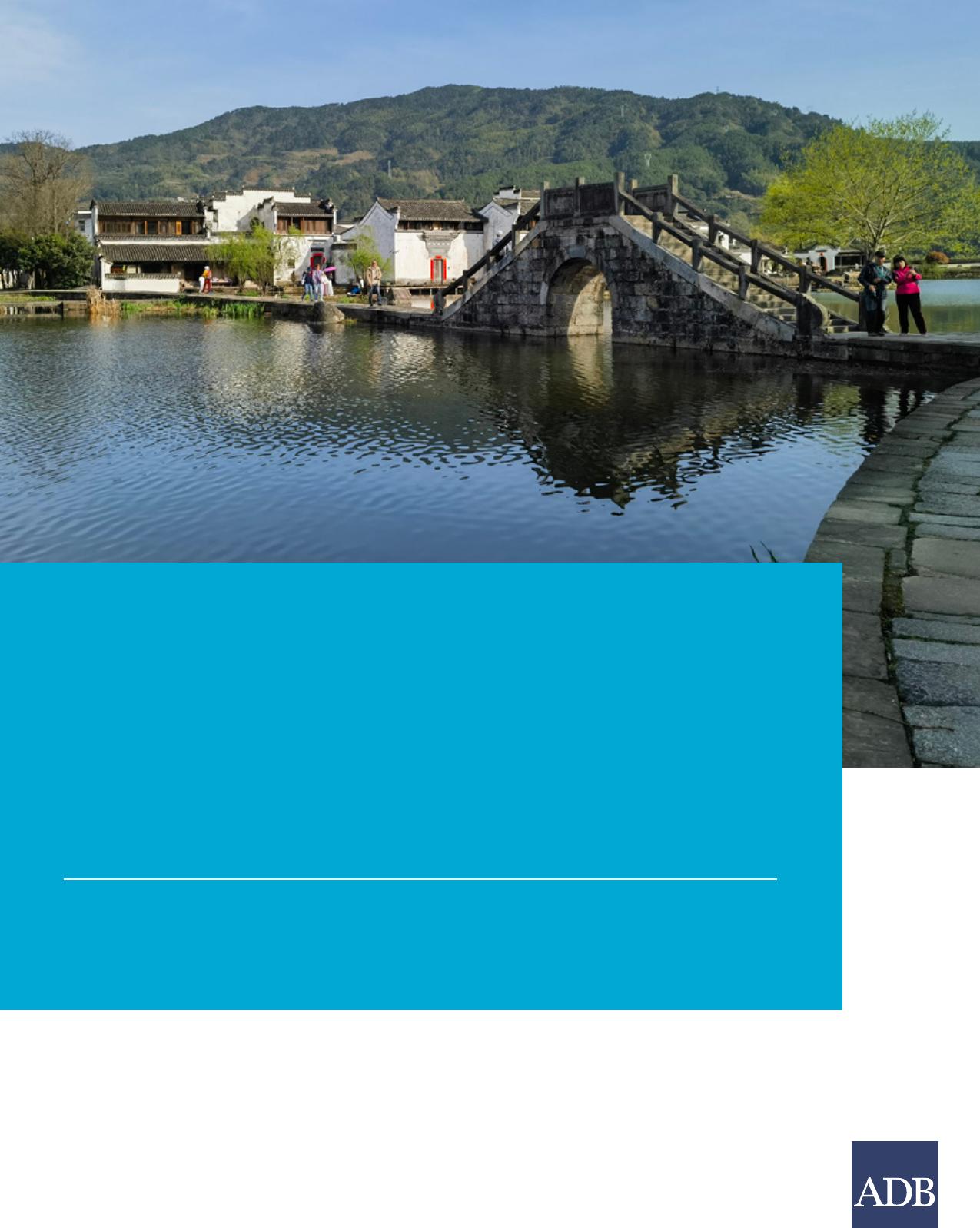SUSTAINABLERURALWASTEWATERMANAGEMENTINTHEPEOPLE’SREPUBLICOFCHINAINSTITUTIONAL,REGULATORY,ANDFINANCIALFRAMEWORKSANDSTAKEHOLDERPARTICIPATIONNOVEMBER2023ASIANDEVELOPMENTBANKSUSTAINABLERURALWASTEWATERMANAGEMENTINTHEPEOPLE’SREPUBLICOFCHINAINSTITUTIONAL,REGULATORY,ANDFINANCIALFRAMEWORKSANDSTAKEHOLDERPARTICIPATIONNOVEMBER2023ASIANDEVELOPMENTBANKCreativeCommonsAttribution3.0IGOlicense(CCBY3.0IGO)©2023AsianDevelopmentBank6ADBAvenue,MandaluyongCity,1550MetroManila,PhilippinesTel+63286324444;Fax+63286362444www.adb.orgSomerightsreserved.Publishedin2023.ISBN978-92-9270-478-0(print);978-92-9270-479-7(electronic);978-92-9270-480-3(ebook)PublicationStockNo.TCS230548-2DOI:http://dx.doi.org/10.22617/TCS230548-2TheviewsexpressedinthispublicationarethoseoftheauthorsanddonotnecessarilyreflecttheviewsandpoliciesoftheAsianDevelopmentBank(ADB)oritsBoardofGovernorsorthegovernmentstheyrepresent.ADBdoesnotguaranteetheaccuracyofthedataincludedinthispublicationandacceptsnoresponsibilityforanyconsequenceoftheiruse.ThementionofspecificcompaniesorproductsofmanufacturersdoesnotimplythattheyareendorsedorrecommendedbyADBinpreferencetoothersofasimilarnaturethatarenotmentioned.Bymakinganydesignationoforreferencetoaparticularterritoryorgeographicarea,orbyusingtheterm“country”inthispublication,ADBdoesnotintendtomakeanyjudgmentsastothelegalorotherstatusofanyterritoryorarea.ThispublicationisavailableundertheCreativeCommonsAttribution3.0IGOlicense(CCBY3.0IGO)https://creativecommons.org/licenses/by/3.0/igo/.Byusingthecontentofthispublication,youagreetobeboundbythetermsofthislicense.Forattribution,translations,adaptations,andpermissions,pleasereadtheprovisionsandtermsofuseathttps://www.adb.org/terms-use#openaccess.ThisCClicensedoesnotapplytonon-ADBcopyrightmaterialsinthispublication.Ifthematerialisattributedtoanothersource,pleasecontactthecopyrightownerorpublisherofthatsourceforpermissiontoreproduceit.ADBcannotbeheldliableforanyclaimsthatariseasaresultofyouruseofthematerial.Pleasecontactpubsmarketing@adb.orgifyouhavequestionsorcommentswithrespecttocontent,orifyouwishtoobtaincopyrightpermissionforyourintendedusethatdoesnotfallwithintheseterms,orforpermissiontousetheADBlogo.CorrigendatoADBpublicationsmaybefoundathttp://www.adb.org/publications/corrigenda.Notes:Inthispublication,“$”referstoUnitedStatesdollars.ADBrecognizes“China”asthePeople’sRepublicofChina;“HongKong”asHongKong,China;and“Macao”asMacau,China.Onthecover:AtraditionalvillageinHuangshanwheretheruralwastewatertreatmentismanagedwell.Therefore,nearbywaterbodyisclean,andthevillageisbeautiful(photobyADB).PrintedonrecycledpaperCONTENTSTABLESANDFIGURES�vACKNOWLEDGMENTS�VIABBREVIATIONS�viiCURRENCYEQUIVALENTS�viiEXECUTIVESUMMARY�viii1.INTRODUCTION�1Background1TechnicalConsideration3ProvincialCases3RuralSanitationApproaches4KeyIssuesandChallenges52.PLANNINGANDDESIGNOFRURALSANITATIONPROGRAMS�7Introduction7SituationAnalysis9ProgramDesign93.INSTITUTIONALSETTING�11NationalLevel12LocalLevel134.POLICIESANDREGULATIONS�14NationalLawsandRegulations14TheRuralVitalizationStrategy,2018–202215LocalRegulations165.FINANCINGANDMANAGEMENTOFRURALWASTEWATER�17SERVICESSourcesofFunds17SocialCapital18iv6.STAKEHOLDERPARTICIPATION�197.INTERNATIONALEXPERIENCEANDGOODPRACTICES�22PrerequisitesforEffectiveRuralSanitation22InternationalGoodPracticesonRuralDevelopment23PrivateSectorParticipation248.THEWAYFORWARD:CONCLUSIONANDRECOMMENDATIONS�25Conclusion25Recommendations26APPENDIXES1SummaryofProvincialCases282AnOverviewofRuralSanitationApproaches333CostingRuralSanitationPrograms354RecentNationalPolicyDocumentsontheTreatmentofRuralDomesticWastewater375RecentProvincialPolicyDocumentsonRuralWastewaterTreatment40TABLESANDFIGURESTABLES1SanitationProgressinthePeople’sRepublicofChina,2015and202072ComponentsofaRuralSanitationServiceDeliveryModel83RolesandResponsibilitiesforRuralWastewaterManagementinthePeople’sRepublicofChina114StakeholderParticipationinaRuralDomesticWastewaterProgram20A1.1PolicyDocumentsonRuralDomesticWastewaterTreatmentinShanxiProvince29A1.2PolicyDocumentsonRuralDomesticWastewaterTreatmentinZhejiangProvince31FIGURESFinancialSourcesfromDifferentSourcesxSourcesofFunds17ACKNOWLEDGMENTSTheauthorsofthispublication—MingyuanFan,principalwaterresourcesspecialistoftheAgriculture,Food,Nature,andRuralDevelopmentSectorOffice(SG-AFNR),AsianDevelopmentBank(ADB);andMatsAndersson,ADBconsultant—wouldliketoexpresstheirgreatappreciationtoADB’sEARDmanagementfortheirvaluableguidance,supervision,andsupport,mostespeciallytoM.TeresaKho,directorgeneral;andThomasPanella,Director,SG-AFNR.Forhiseffortsandinsightfulcommentsaspeerreviewer,theauthorsaregratefultoJudeKohlhase,unithead,projectadministration,WaterandUrbanDevelopmentSectorOffice.Thispublicationisbasedontheconsultants’finalreport,InstitutionalandRegulatoryFrameworkforRuralWastewaterManagementinthePRC(People’sRepublicofChina),undertheRuralVitalization—RuralWastewaterTreatmentandEnvironmentalManagementProject(TA9825-PRC),authoredbyLiShuang,YuWencan,JoeyShenandZhaoQihong.FeiYuehasprovidedguidancetotheteamandreviewedthefinalreport.TheexpertpanelofpeerreviewerscomprisedZhangXiaowen,ShiYi,WuYubing,XinZhiwei,andMaZhong.JoyQuitazol-Gonzalezfacilitatedthepublishingofthisknowledgeproduct,includingthefinalreviewofthedraftreport.TheauthorswouldalsoliketothankSophiaCastillo-Plaza,EAOD;ChristianFischer,andJesusaQuinto,SG-AFNRfortheirassistance.ABBREVIATIONSCAOCentralAgriculturalOfficeCHASTchildhygieneandsanitationtrainingCHCcommunityhealthclubsCLTScommunity-ledtotalsanitationCPCCommunistPartyofChinaMARAMinistryofAgricultureandRuralAffairsMEEMinistryofEcologyandEnvironmentMHURDMinistryofHousingandUrban–RuralDevelopmentMOFMinistryofFinanceNDRCNationalDevelopmentandReformCommissionO&MoperationandmaintenancePHASTparticipatoryhygieneandsanitationtransformationPRCPeople’sRepublicofChinaRWWMruralwastewatermanagementSDGSustainableDevelopmentGoalsSLTSschool-ledtotalsanitationUNICEFUnitedNationsChildren’sFundWHOWorldHealthOrganizationCURRENCYEQUIVALENTSAsofOctober2023CNY1.00=$0.136CNY7.31$1.00=EXECUTIVESUMMARYThepurposeofthistechnicalpaperistoprovideanoutlineofthecurrentinstitutionalandregulatoryframeworkforruralwastewatermanagement(RWWM)inthePeople’sRepublicofChina(PRC).Inthiscontext,RWWMrefersbroadlytotheprovisionofwastewaterservices(fromcollectiontotreatmentandreuseofwastewater)inconjunctionwiththerationalandsustainableuseofnaturalresources.Thispaperhighlightstheexistinginstitutionalarrangementsandrecentpolicydevelopments,includingregulations,fundingarrangements,andeducationandparticipatoryapproaches.Technicalwastewatermanagementsolutionsandoperationalguidelines,includingoperationandmaintenance(O&M)matters,willnotbediscussedinthispaper.AsummaryofprovincialcasestudiesinthePRCisincludedinAppendix1.Thecasesshowthechallengesfacedandtheachievementsaccomplishedunderdifferentlocalcircumstancesacrossthecountry.AnoverviewofruralsanitationapproachesisoutlinedinAppendix2.Ruralsanitationapproachesaimtoimprovethesanitation,hygiene,andwaterconditionsofruralareasthroughproperRWWM,whicharecriticalforthesustainablegrowthofruralcommunities.Internationalexperiencesintheplanninganddesignofruralsanitationprogramsarelikewisediscussed,includingthecostofruralsanitationprograms(Appendix3).InstitutionalFrameworkAnestablisheddecision-makingandcoordinationmechanismforpromotingRWWMexistsunderthedirectleadershipandguidanceoftheCommunistPartyofChina(CPC)andthegovernmentthroughouttheadministrativehierarchy(provincial,city,county,township,andvillagelevels).Strategiesaresetatthecentrallevel,andgeneralcoordinationisarrangedthroughadivisionoflaboramongthelineministries.Theimplementationisaccomplishedatthelocallevel,mainlythrougheffortsatthecityandcountylevels.Theircapacityisconstrained,however,bylocalconditions,suchastheavailabilityofnaturalresources,theirdevelopmentstatus,andfunding.Atthecentrallevel,theCentralAgriculturalOffice(CAO)istheforemostbodyforpolicymakingandcoordinationofissuesrelatingtothelivelihoodoffarmers,agriculturaldevelopment,andruraldevelopmentbroadly.TheCAOhasanofficeintheMinistryofAgricultureandRuralAffairs(MARA)whichisinchargeofdailyoperationsandisheadedbytheagricultureminister.TheGuidanceonPromotingRuralWastewaterManagement,jointlyissuedin2019bytheCAOandeightconcernedministries,setsoutthethree-levelgovernancestructureforimprovingRWWM.Strategictargetsaresetatthecentrallevel,deliveryresponsibilityisassignedtotheprovinciallevel,andimplementationistheresponsibilityofthecitiesandcounties.MARAleadstheimprovementofrurallivingconditions,whiletheMinistryofEcologyandEnvironment(MEE)isresponsibleforimprovingtheRWWM.ExecutiveSummaryixPolicyandRegulatoryFrameworkSince2016,15keypolicydocumentsforimprovedRWWMhavebeenissuedbythecentralgovernmentofthePRC.ThesearefoundinAppendix4.Theyincludestrategies,programs,actionplans,guidelinesontechnicalnormsandstandards,dischargestandards,institutionalarrangements,andguidanceonencouragingtheprivatesectortoparticipateinprovidingRWWMservices.TherearenospecificlawsforruraldomesticwastewatertreatmentatthenationallevelinthePRC,butmanyprovinceshaveissuedregulations,includinglocaldischargestandards.ZhejiangProvinceinthecountry’ssoutheastisapioneerinRWWM;itissuedthefirstlocalregulationonRWWMinJanuary2020,whichprovidesausefulreferenceforotherprovinces.Appendix5providesalistoflocalpolicydocuments,strategies,andregulationsforimprovedRWWMissuedby16provincialgovernments.Theyincludeprovincial-levelprograms,specificactionplans,operationalguidelines,andmonitoringandassessmentmechanisms.RWWMpoliciesandregulationsarestillunderdevelopmentinthePRC,followingaphasedapproachbyimplementingdemonstrationcasesinsomeprovincesbeforeupscalingandreplication.Underthegovernment’seconomicdevelopmentstrategy(i.e.,the13thFive-YearPlan[2016–2020]),thefocuswasondevelopingnationalprinciplesandstandardstoguidelocaldecision-making,particularlyexecutingdemonstrationcasesatthecountylevelthatalignwiththenewprinciplesandstandards.The14thFive-YearPlan(2021–2025)isorientedtowardupscalingandreplication,withanemphasisonadaptingtolocalconditionsanddemand.Theoverallaimunderthecurrent14thplanisforcommunitiestoachieveafunctionalsystemofensuredservicestandardsandoperationalsustainabilityacrossthecountry.Topromotesustainableruraldevelopmentandimproverurallivelihoods,thegeneralofficesoftheCPCCentralCommitteeandtheStateCounciljointlyreleasedinFebruary2018theThree-YearActionPlanforRuralLivingEnvironmentRenovation.Theactionplanincludesrequirementsforwastewatermanagementandtoiletrenovationinruralareas.ThecentralgovernmentlaunchedtheRuralVitalizationStrategyin2018,andthentheRuralVitalizationStrategyPlan(2018–2022).FinancingTheNationalDevelopmentandReformCommission(NDRC)leadsthedevelopmentofthepricingmechanismforruralwastewatertreatmentservicesandtheexplorationofappropriatecost-sharingmechanismsamongstakeholders.RWWMismainlyfinancedatthelocallevel,complementedbyfundingsupportfromthecentralgovernmentandcontributionsfromtheprivatesector.ThecentralgovernmentsupportismanagedbytheMinistryofFinance,incooperationwiththeMEE.Theyprovidespecialfundsforimprovingruralenvironmentalmanagement,includingsupportforsolidwastemanagement,ruralwastewatermanagement,watersourceprotection,andrehabilitation.Attheprovinciallevel,theCPCandrelevantgovernmentareresponsibleforensuringanenablingenvironmentfortheimplementationofRWWM.TheCPCandthecityandcountygovernmentsarethekeyentitiesforpreparingprojectproposalsandensuringthesuccessfulimplementationofRWWM.Thetownshiplevelorganizesandsupervisestheday-to-dayconstructionandoperationoftheruralwastewatertreatmentfacilities.Atthevillagelevel,theCPCpromotestheawarenessofgoodhygieneandruralsanitationpracticesamongfarmers.xExecutiveSummaryFigure:FinancialSourcesfromDifferentSourcesSupportfromtheSupportfromPrivatesectorFundingfromPaymentsbycentralgovernmentlocalgovernmentsparticipationfinancialinstitutionsruralhouseholdsSource:AsianDevelopmentBank.Tobuildruralwastewatertreatmentfacilitiesandimprovetheirefficiency,local(provincial,city,andcounty)governmentscanintegratefinancialresourcesfromdifferentsources.TheymayissuebondsforRWWMandareencouragedtoworkwiththeprivatesectoronthesubjectthroughpublic–privatepartnershiparrangements.In-kindcontributionsfromvillagers,investments,ordonationsfromtheprivatesectorandindividualsarealsoencouraged.Toensureoperationalsustainability,someprovincesrequirethatcitiesorcountiesincludeanallocationforupgradingandO&Moftheruralwastewatertreatmentfacilitiesintheirannualbudgets.Financingchannelsincludethefollowing:•Supportfromthecentralgovernment.ThecityorcountygovernmentsaretheprimarysourceoffinancingforimprovedRWWM.Centralgovernmentprovidesfinancingsupporttoencouragetheconcernedlocalgovernments,particularlythoseinlessdevelopedregions,toprotectandrehabilitatewatersourcesandimprovetheirruralsolidwasteandwastewatermanagementpractices.•Supportfromlocalgovernments.Localgovernmentsarerequiredtoensurefundingforimprovedrurallivingconditions,mainlythroughtheissuanceofbondsorrevenuesfromlanddevelopment.Countygovernmentscanuseresourcesfromdifferentchannelsattheirdiscretiontoensuretheimplementationofdevelopmentprograms.•Privatesectorparticipation.Whileprivatesectorinvestorsorserviceprovidersareencouraged,thechallengeistocreateasteadystreamofrevenuestoensurethattheycangetanappropriatereturnontheirinvestmentsovertime.•Fundingfromfinancialinstitutions.Loansfromthecommercialfinancialsectorfacesimilarchallengesasprivatesectorinvestments:ensuringanadequatereturnwhilebeingmanageableforthelocalgovernmentsorcommunitiesasborrowers.•Paymentsbyruralhouseholds.Whilethisisthesolutioninthemediumandlongerterm,presentlyinmostprovinces,ruralhouseholdsshoulderasmallportionoftheO&Mcostoftreatmentfacilitiesduetoaffordabilityconstraints.Insummary,RWWMatpresentrequiresfundingsupportfromthepublicsectorforbothconstructionandO&Moftreatmentfacilities.Tariffpaymentsbyhouseholdsareunlikelysufficientastheprimarysourceofshort-termfinancing.Privatesectorparticipationneedslong-termfinancingsupportfromthegovernmenttoensureappropriatereturnsontheirinvestments.ExecutiveSummaryxiConclusionsandRecommendationsTheinstitutionalarrangementforpromotingandsupportingRWWMamongthecentralgovernmentministriesneedstobefurtherclarified,particularlybetweenthedifferentlayersofthegovernmenthierarchyatthecentral,provincial,andlocallevels.ItiscriticaltoimprovecoordinationtoensureeffectiveimplementationofRWWM.LegislationandcorrespondingregulationsforRWWMshouldbeformulatedatthecentral,provincial,andlocallevelstoprovidearobustlegalandregulatoryframeworktoenableandsustainimprovedruralwastewatertreatmentandmanagementperformance.Further,amonitoringsystemmustensuretransparencyandmeasureperformanceaccurately.TheseactionswouldfacilitatetheadvancementofsustainabledevelopmentoftheRWWMinthecountry.ThemostappropriatecostrecoverymechanismsandbusinessmodelsshouldcontinuetobeexploredtoencouragetheprivatesectortoengageinRWWM,asinvestorsand/orserviceproviders.1INTRODUCTIONBackgroundThePeople’sRepublicofChina(PRC)hasrecordedimpressiveprogressinreducingpovertyandimprovingnutrition.1In2021,thePRCgovernmentannouncedthataccordingtoitsnationalpovertythreshold,ithadexpungedextremepoverty.2Between2015and2020,accessinruralareastodrinkingwaterimprovedfrom84.5%to89.7%,andaccesstobasicandsafelymanagedsanitationimprovedfrom76.5%to87.9%.3Despitesuchprogress,manychallengesremaininruralareas.Intensiveagriculture,economicdevelopmentinvillagesandsmalltowns,andthegrowthoftourismhaveincreasedenvironmentalandecologicalpressures.Bothpointsourcepollution(sewage)andnonpointsourcepollution(agriculture-basedandotherrunoff)haveimpairedwatersafetyinmanyareas.Poorlymaintainedoralackofpublicinfrastructureandsanitationservicesaffectpeople’slivingconditionsandhaveresultedinthedirectdischargeofdomesticpollutantsintogroundwaterandsurfacewaterbodies.4RuralwastewatertreatmentiscrucialtoimprovethePRC’srurallivingenvironment(e.g.,topreventgastrointestinaldiseases,cholera,typhoid,stunting,etc).5Itisanimportantmeasuretoimprovetheeffectivenessoftheimplementationofthecountry’sruralvitalizationstrategyandaninherentrequirementtoimprovethequalityoftheruralwaterenvironment.6Householdsthatareeconomicallydisadvantagedandgeographicallyisolatedhavegreaterdifficultyobtainingaccesstowastewaterservices.Inrecentyears,allprovincesinthePRChaveactivelypromotedruralwastewatertreatmentandachievedsignificantresults.Thishasplayedavitalroleinimprovingtheecologicalenvironmentofruralareas,enhancingthequalityoflifeoffarmers,andpromotingagriculturalandruralmodernization.1Basedonthecountry’sofficialpovertylineoflessthan$2.15aday(2017purchasingpowerparity),thecountry’spovertyrationdecreasedfrom72.0%in1990to0.1%in2019;WorldBank.PovertyandInequalityPlatform.https://data.worldbank.org/indicator/SI.POV.DDAY?locations=CN(accessed16May2023).2WorldBankandDevelopmentResearchCenteroftheStateCouncilofthePRC.2022.FourDecadesofPovertyReductioninChina:Drivers,InsightsfortheWorld,andtheWayAhead.Washington,DC:WorldBank.https://thedocs.worldbank.org/en/doc/bdadc16a4f5c1c88a839c0f905cde802-0070012022/original/Poverty-Synthesis-Report-final.pdf.3WorldHealthOrganization(WHO)/UnitedNationsChildren’sFund(UNICEF)JointMonitoringProgramme.Water,SanitationandHygiene(WASH).RuralandUrbanSanitationServiceLevels,2015and2020:HouseholdDatabyServiceLevel.https://washdata.org/data/household#!/(accessed17May2023).4Itisestimatedthat85%ofthenonpointsourcepollutioninthePRCisderivedfromruralsources,particularlythedischargeofpollutantssuchastotalnitrogenandtotalphosphorusfromagriculturalactivities.Thedispersednatureoftheseactivitiesmakesthecontrolofnonpointsourcepollutionamajorchallenge.However,thistopicisnotaddressedinthisdocument,whichfocusesondomestic(household)sanitation.5Ruralwastewatertreatmentreferstodomestic(household)wastewater,notindustrialoragriculturalwastewatermanagement.6CentralCommitteeoftheCommunistPartyofChinaandtheStateCouncilofthePRC.2018.GuidelinesfortheImplementationoftheRuralRevitalizationStrategy.Beijing.2SustainableRuralWastewaterManagementinthePeople’sRepublicofChinaTheGovernmentofthePRCidentifiesruralwastewatermanagement(RWWM)asanimportantissueandisreflectedinthefollowingfive-yearplans:(i)13thFive-YearPlan(2016–2020),7whichfocusedondevelopingnationalprinciplesandstandardstoguideimplementation,particularlydemonstrationcasesatthecountylevel;and(ii)14thFive-YearPlan(2021–2025),8whichaimstoupscaleandreplicatesuccessfulcasesusingaphasedapproachwithgreateremphasisonprojectdesignsbasedonlocalconditionsandneeds.Theoverallaimofthecurrentplanisforcommunitiestoachievefunctionalsystemswithensuredservicestandardsandoperationalsustainabilityacrossthecountry.Attheendof2010,thePRC’sruralpopulationwas552million(39%ofthetotalpopulation)9andscatteredacrossabout500,000administrativevillagesand2.5millionnaturalvillages.10ThePRC’sannualinvestmentinruralwastewatertreatmentincreasedfromCNY12.6billionin2016toCNY75.4billionin2020—asixfoldincrease.11Duringthesameperiod,treatmentcapacitydoubledfrom25.3millioncubicmetersperdayto51.0millioncubicmetersperday.In2006,thenationalaverageannualrateofincreaseinruralwastewaterserviceswasreportedat1%.Itincreasedto6%by2010andto10%by2014.Attheendof2018,ruralwastewaterservicecoveragerangedfrom10%to90%,dependingontheregion.Thereisstillsignificantroomforimprovement,particularlyinvillages.ResponsibilityforpromotingRWWMfallsunderboththeCommunistPartyofChina(CPC)andtheadministrativehierarchyofthegovernment(attheprovincial,city,county,township,andvillagelevels).Atthenationallevel,thegovernmenthasestablishedacomprehensivemanagementstructureforthepromotionofruralwastewatertreatment,withrelevantdepartmentscoordinatedbytheCAOintheMinistryofAgricultureandRuralAffairs(MARA).12TheCAOhasissuedpoliciesandregulationstoguidethecountryonthesubject,andconsiderableresultshavebeenachievedinrecentyears.Thenationalgovernment’spolicyonruralwastewatertreatmentisbasedontheprincipleofadaptingmeasurestolocalconditionsandprogressingstepbystep.The13thFive-YearPlanfocusedondemonstrationprojects,constructionoffacilitiesinstages,andprinciplesandguidelinesfromthecentralgovernment.The14thFive-YearPlanbuildsonthe13thFive-YearPlan,addressingconstruction,management,andoperations.Itaimstoestablishalong-termpolicysystemandpromotionmechanism.Topromotesustainableruraldevelopmentandimprovepeople’slivelihoodsinruralareas,theGeneralOfficeoftheCPCCentralCommitteeandtheGeneralOfficeoftheStateCounciljointlyreleasedtheThree-YearActionPlanforRuralLivingEnvironmentRenovationinFebruary2018,withrequirementsonwastewatermanagementandtoiletrenovationinruralareas.13Thecentral7GovernmentofthePRC,MinistryofEnvironmentalProtection,andMinistryofFinance.2017.The13thFive-YearPlan(2016–2020)forComprehensiveImprovementoftheNationalRuralEnvironment.Beijing.8GovernmentofthePRC.2021.The14thFive-YearPlan(2021–2025)forNationalEconomicandSocialDevelopmentandtheLong-RangeObjectivesThroughtheYear2035.Beijing.9NationalBureauofStatisticsofChina.2021.2020ChinaStatisticalYearbook.Beijing:ChinaStatisticsPress.10Anadministrativevillageisalevel5administrativedivisioninthePRC,whichfallsunderthetownship(level4),county(level3),city(level2),andprovince(level1).Somevillages,however,arenotadministrativevillagesbutnaturalvillages.Naturalvillagesarecommunitiesformedspontaneouslythroughsettlementchoicesoveralongperiodoftime.Theyare“thebasicruraladministrativeunits,thelowest-levelcollectivelandmanagementunits,andtheprimarylocusofcollectivelaborandincomedistributionoftheMaoistera.”(YiWu.2016.LandRights,PoliticalDifferentiation,andChina’sChangingLandMarket:BoundedCollectivismandContemporaryVillageAdministration.TheAsia-PacificJournal.14(1).No.3.ArticleID4842).11GovernmentofthePRC,MinistryofHousingandUrban–RuralDevelopment.2021.ChinaUrban–RuralConstructionStatisticalYearbook2020.Beijing:ChinaStatisticsPress.12MARAwasestablishedin2018bymergingthefunctionsofthepreviousMinistryofAgriculturewiththeagriculture-relatedresponsibilitiesofseveralotheragencies(i.e.,theMinistryofFinance,theMinistryofLandandResources,theMinistryofWaterResources,andtheNationalDevelopmentandReformCommission)tostreamlinethegovernmentandimproveitsefficiencyinpromotingruraldevelopment.13E.Tangen.2018.ChinaUnveilsActionPlanforImprovingRuralLivingEnvironment.ChinaToday.28February.Introduction3government,in2018,alsolaunchedtheRuralVitalizationStrategyandissuedtheRuralVitalizationStrategyPlan(2018–2022).14TheRuralVitalizationStrategyPlanpromoteslocalizedruralsanitationmanagementandinnovativeRWWMmodelstorehabilitateecologicalenvironmentsandimprovethecharacterofthecommunity,includingthelivabilityofruralvillages.ThereisnospecificnationallawnorrelatedregulationsforruraldomesticwastewaterinthePRC.NeithertheWaterLaw(2002)northeWaterPollutionPreventionandControlLaw(amendedin2017)covertheissuenorspecifytheresponsibledepartmentsforruralwastewaterinthecountry.Thesubjectisaddressedindirectlyinnationalpublichealthlegislation(e.g.,ondischargestandards)andlocalregulations.Someprovinceshaveissuedregulationsforruraldomesticwastewatertreatment;however,theselacklegislativebasis,andthemanagementlevelsvarysignificantlyonthesubject.Forexample,ZhejiangProvincehasformedanadvancedpolicysystemregulatingtheconstruction,management,andoperationandmaintenance(O&M)ofruraldomesticwastewatertreatmentsystems.Someprovincesarestillintheearlystagesoffacilityconstruction.TechnicalConsiderationsRuralvillagesproducewastewater,thevolumeofwhichiscloselyassociatedwiththeirwaterusage.Increasedwatersupplycreatesaneedformanagingagreatervolumeofwastewater.InthePRC,ruralareasgeneratewastewaterthatisabout60%–80%oftheirwaterusagevolume.RuralwastewaterservicesinthePRCcanbeclassifiedasdecentralizedorcentralizedsystems.Adecentralizedsystemisasysteminstalledandmanagedon-site,atthehouseholdlevelorinthehousehold.Adecentralizedsystemcanalsobeasystemwherehouseholdsaregroupedandconnectedtoasmallneighborhoodsystem.Thisisknownasamixedsystem.Acentralizedwastewatersystemtypicallycomprisesacommunity-levelsystemforsewagecollection,treatment,anddisposal.AnyRWWMinitiativeshouldassessthecostsandbenefitsofadecentralizedsystemversusacentralizedone.Sometechnologiescanbecomplexandcostlytooperateandmaintainduetotheirrequiredconsumablematerials(e.g.,chemicals)andspareparts(e.g.,filters).Toarriveateconomicandmoresustainablesolutions,inadditiontothecommunityneeds,thelocation,geography,soiltype,hydrogeology,climate,andotherenvironmentalfactorsneedtobeexaminedaswell.TechnicalsolutionsandoperationalguidelinesofRWWMarenotcoveredinthispaper.ProvincialCasesThecasestudiesofRWWMinJiangsu,Shanxi,andZhejiangprovincesaresummarizedinAppendix1,includingfinancingmechanismsappliedandprivatesectorparticipation.RWWMisatthemostadvanceddevelopmentstageinZhejiangProvince,whileJiangsuProvinceisatthemid-rangeandpresentlymoreadvancedthanShanxiProvince.Duetohistoricalreasons,somelocalgovernmentsuseaninstitutionalarrangementthatisquitedifferentfromwhatisestablishedattheprovincialornationallevel.Forexample,theMinistryofHousingandUrban–RuralDevelopment(MHURD)isresponsibleforRWWMimplementationinZhejiangProvince,whileMEEistheleadingagencyinShanxiProvince.14Xinhua.2018.ChinaReleasesFive-YearPlanonRuralVitalizationStrategy.TheStateCouncilofthePeople’sRepublicofChina.26September.4SustainableRuralWastewaterManagementinthePeople’sRepublicofChinaEveninthecaseofZhejiangProvince,whichhasthemostadvantageousnaturalresources,itisdifficulttoenforcethe“polluter-paysprinciple.”Ithasinsteadadoptedagradualapproachforits(individualandcluster)householdpaymentsystemtocoverpartoftheO&Mcostsforitsruralwastewatertreatmentservices.Localgovernmentstendtoeithergroupwastewatertreatmentservicesforclustersofvillagesandtownshipsorcombinetheservicewithotherpublicservices(e.g.,watersupply,power,orsolidwastedisposal)toensureeconomiesofscaleforprivatesectorinvestors.Considerationsforclusteringservicesaredependentonthecapacityofavillagetomanageassetsanddelivertheservices.Somelocalgovernments,suchasinJiangsu,Shanxi,andZhejiangprovinces,havedevelopedinstitutionalarrangementsandmonitoringtechniquesforthesupervisionofprivatesectorserviceproviderstoensurequalityservice.Thesecasesserveasdemonstrationcasesforpotentialreplicationinotherpartsofthecountry.RuralSanitationApproachesAnarrayofapproachesareemployedtoimprovethesanitationconditionsofruralcommunities.15Appendix2providesanoverviewofthese.Someapproachesemphasizechangingindividualbehaviors,whileothersfocusoncollectivechangeandgeneratingawareness.Organizationsandgovernmentsalsosometimesmandatethetypesofapproachestobeusedincertaingeographicalareasorforaparticularcontext.Directivesforthestrictadherencetothesemandatedapproachescaninhibitadaptation,modification,orinnovation,orevenhamperproperdocumentationof“blended”and“unorthodox”approaches.Asaresult,the“whys”and“hows”behindthesuccessesandfailuresofruralsanitationapproachescanbeobscured,thwartingmovestowardmorecontext-appropriate,flexible,andresponsiveruralsanitationprogramming.Large-scaleruralsanitationprogramsforaparticulargeographicalareawithinternationalsupporthaveusuallyappliedthefollowingprinciples:•usinganarea-wideapproach,withemphasisonsocialinclusion,completecoverage,andsustainableservicesforthepoorestpeople;•strivingforaccessforall(universalcoverage),byaddressingequityandprocessesofexclusionthroughinnovationandguaranteeinggenderequality;•promotingsustainablebehavioralchange,particularlyintermsofcleandrinkingwater,sanitation,andhygiene;and•implementingsystemschange,bothintheinstitutionsandfinancialsystemswhereservicesareembedded,andinconsiderationofthechecksandbalancesofthesystemsandtheirinterconnectedness.15BasedonthereportReviewofRuralSanitationApproaches,publishedinAugust2017andcommissionedbyWaterAid,PlanInternational,andtheUnitedNationsChildren’sFund(UNICEF).Introduction5Designinganarea-wideruralsanitationprogram(e.g.,foroneormorecounties)shouldaimtomeetthesanitationtargetoftheUnitedNation’sSustainableDevelopmentGoals(SDG6)16by(i)promotinguniversalaccesstosafelymanagedsanitationandhygiene,(ii)eliminatingopendefecation,(iii)progressivelyreducinginequalitiesamongpopulationsubgroups,and(iv)alleviatingsanitationandhygieneburdensforwomenandgirls.Thiswillrequireinclusiveandeffectiveprogramming,aswellasattentiontothescale,sustainability,17andequityofprogramdesign,selectionofimplementationapproach,andmonitoringofsustainedoutcomes.KeyIssuesandChallengesSince2010,ruralsanitationandwastewatermanagementinthePRChasimprovedsignificantlyasaresultofintensivegovernmentinvestment.Manyvillageshaveinstalledsanitarytoilets,whichareeitherconnectedtopublicsewersoron-sitewastewatertreatmentfacilities.Nevertheless,practicalproblemssuchasinsufficientlocalattentionandthedifficultyofchangingthehabitsofresidentspersist,andregulatorydevelopmentsareslow.Someoftheseissuesaresummarizedasfollows.InstitutionalSetting•Thereareambiguitiesregardingtheresponsibilitiesofruralwastewatertreatment.The2018nationalinstitutionalreformplacestheresponsibilityforconstructingruralwastewatertreatmentfacilitiesontheMEEatthenationallevel.Theleaddepartment,however,attheprovinciallevelcanvary—e.g.,theMEEistheleadingagencyinShanxiProvince,whiletheMHURDistheresponsibleagencyinZhejiangProvince.Thismayincreasethedifficultyofimplementingpoliciesandregulations.PoliciesandRegulations•ThereisnospecificlawonruralwastewaterandsanitationinthePRC.Thesubjectisaddressedindirectlyinnationalpublichealthlegislation(e.g.,ondischargestandards)andinlocalregulations.•TheexistingpoliciesandregulationsonRWMMarenotresponsiveandarenotclearenoughtosupporteffectiveplanningandoperations.•Theruralwastewaterdischargestandardsdeterminetheprocessselection,equipmentconfiguration,andO&Mcostsoftreatmentfacilities.Althoughtheauthoritiesemphasizethatsuchstandardsshouldbeadaptedtolocalconditions(includinglocaleconomicdevelopmentlevelandmanagementcapabilities)andneedtohavetechnicalfeasibility,mostofthedischargestandardsappliedbylocalgovernmentstillreflecthigherstandardsandstricterrequirementsthannecessary.ThisincreasesinvestmentandO&Mcostsandmayleadtoanunsustainabledevelopmentsituation.•Theprovincialenforcementofeffluentstandardsisweak.16By2030,endopendefecationandachieveuniversalaccesstoadequateandpropersanitationandhygiene,particularlyfocusingontheneedsofvulnerablegroups,includingwomenandgirls.17L.Seghezzo.2009.TheFiveDimensionsofSustainability.EnvironmentalPolitics.Thefivedimensionsofsustainabilityare(i)institutionalsustainability(Doinstitutionsfulfilltheirrolesandresponsibilitiescontinuouslyovertime?);(ii)financialsustainability(Arethereadequatefinancesforinstitutions,services,andoutcomesovertime?);(iii)functionalsustainability(Dofacilitiesandservicescontinuetofunctionovertime?);(iv)equitysustainability(Areservicesandoutcomesequitableovertime?);and(v)environmentalsustainability.6SustainableRuralWastewaterManagementinthePeople’sRepublicofChinaFinancing•Thefinancingapproachesofruralwastewatertreatmentfacilitiesareunsustainable,relyingheavilyongovernmentfinancingandsubsidies.Thefundingforruralwastewatertreatmentismainlyfromlocalgovernments,withsomerewardsandsubsidiesprovidedbythecentralgovernment.•Duetotheuncertainreturnsofruralwastewaterprojects,enthusiasmforprivateparticipationislow.•Atariffpaymentsystembyfarmersisbeingpilotedinsomeareaswhereconditionspermit,butconsideringthelimitedcapacitytopayoffmostruralvillagersinthePRC,thisisnotexpectedtobetheprimarysourceoffundinginthelong-term.•AcostrecoverymechanismforsufficientO&Moffacilitiestoensureitssustainabilityislacking.StakeholderParticipation•Thereisinadequatestakeholderparticipationin,publicawarenessof,andownershipofRWWMinitiatives,whichhamperthedeliveryofgoodenvironmentalandpublichealthoutcomes.2PLANNINGANDDESIGNOFRURALSANITATIONPROGRAMSIntroductionTheWorldHealthOrganization(WHO)/UnitedNationsChildren’sFund(UNICEF)JointMonitoringProgrammeforWaterSupply,Sanitation,andHygienedefinesimprovedsanitationasfacilitiesthatareusedandensurehygienicseparationofhumanexcretafromhumancontact.Thesefacilitiesrangefromflushorpour–flushtoiletsorlatrines,pitlatrineswithaslab,orventilatedimprovedpitlatrines,toaseptictank,compostingtoilet,andpipedsewersystem.18Accordingtotheprogram,in2020,thePRC’ssanitationfacilitycoverageinruralareaswas90.6%,comparedto97.6%inurbanareas.Theseruralsanitationfacilitiesincludesewers(40.4%),septictanks(15.2%),andlatrines(35.0%).19Table2.1presentstheprogressinsanitationinthePRC’sruralandurbanareasin2015and2020.Thisshowsthatsanitationproblemsaremostacuteinruralareas.Table1:SanitationProgressinthePeople’sRepublicofChina,2015and2020(%)RuralAreasUrbanAreasSanitationSystem2015202020152020OpenDefecation1.20.30.20.3SystemFacilities2.72.73.52.5•Limited19.69.15.62.0•Unimproved47.044.020.19.6•BasicSanitation29.543.970.785.6•SafelyManaged100.0100.0100.0100.0TotalNote:Percentagesmaynottotal100%becauseofrounding.Source:WorldHealthOrganization(WHO)/UnitedNationsChildren’sFund(UNICEF)JointMonitoringProgramme.Water,SanitationandHygiene(WASH).RuralandUrbanSanitationServiceLevels,2015and2020:HouseholdDatabyServiceLevel.https://washdata.org/data/household#!/(accessed17May2023).18WHO/UNICEFJointMonitoringProgrammeforWaterSupplyandSanitation.2010.ProgressonSanitationandDrinkingWater—2010Update.Geneva:WHO.19WHO/UNICEFJointMonitoringProgramme.Water,SanitationandHygiene(WASH).RuralandUrbanSanitationServiceLevels,2015and2020:HouseholdDatabyFacilityType.https://washdata.org/data/household#!/dashboard/new(accessed17May2023).8SustainableRuralWastewaterManagementinthePeople’sRepublicofChinaAprogrammaticsanitationstrategyhastwoprincipalobjectives:(i)encouragingbehaviorchangeatthecommunity-wideleveltoputanendtoopendefecationandtoimprovefacilitiesandpractices,and(ii)stimulatingdemandforsanitationproductswhileconcurrentlyfosteringaffordableandreliablesupplies.Amongtheprogrammaticapproachesemployedtochangebehaviors,createdemand,andincreasethesupplyofgoodsandservices(improvingsanitationsupplychains)arecommunity-ledtotalsanitation,behaviorchangecommunication,20sanitationmarketing,andsometimesacombinationofthethree(Appendix2).Theyarecompatibleandcomplementeachotherinachievingsustainablefacilitiesandbehaviorchange.21Forcommunity-ledtotalsanitation,cooperationandsocialsolidarityamongcommunityhouseholdsarevitalelements.Behaviorchangecommunicationintegratesbestpracticesfromsocialandcommercialmarketing.22Forsanitationmarketing,theapplicationofthe“FourPs”(product,price,place,andpromotion)augmentsdemandandsupplyforimprovedsanitation,especiallyamongpoorpeople.Operationalizingaprogrammaticapproachforsustainableservicedeliveryatscalerequiresengagementbyallstakeholders—national,provincial,andlocalgovernments;thecommunitiesorvillagecommittees;households;theprivatesector;anddevelopmentpartners.Table2.2summarizestherolesofthesekeystakeholders.Thenationalandprovincialgovernmentswillestablishandmaintainastrongenablingenvironment,whereasthelocalgovernmentswillmanagetheimplementation.Capacitybuildingshouldbestrengthenedforlocalgovernments,theprivatesector,andresourceagencies.Table2:ComponentsofaRuralSanitationServiceDeliveryModelStakeholderKeyRoleNational/ProvincialGovernmentLocalGovernmentCreateenablingenvironmentsforsustainableandlarge-scalesanitationprogramsImprovesanitation,establishregulation,definestrategiesandplans,enableandCommunities/VillageCommitteesregulatetheprivatesector,strengthenadvocacyandcapacitybuilding,andfacilitateHouseholdsmonitoringandevaluationPrivateSectorPromoteunityforimprovedsanitationDevelopmentPartnersArrange,utilize,andmaintainimprovedsanitationfacilitiesProducesanitationproductsandservicesSource:AsianDevelopmentBank.Providetechnicalguidanceintermsofplanning,design,implementation,andmonitoringofruralsanitationprogramsEffectivedesignandimplementationofsustainableandlarge-scaleruralsanitationprogramsrequiresystematicinstitutionalandpolicysupport,strongstakeholderdeliverysupport,andfinancingstrategiesthatarebothaffordableandaccessibletopoorpeople.Ensuringthesupplyofsanitationproductsandservicesinruralareascanbeacriticalpartofsanitationmarketing,overcomingsupply20Behaviorchangecommunicationisresearchanddevelopmentofcommunicationmaterialsforpromotingpositiveeconomic,health,and/orsocialoutcomes.Itbuildsonanunderstandingofthefactorsaffectinghouseholddemandaswellasopportunitiesandconstraintsinthesanitationsupplychain.Theevidenceneededtodevelopaneffectiveandsustainablesanitationmarketingprogramoftenrequiresprimaryresearch,whichentailsthecollectionofinformationdirectlyfromthehouseholds.21Manyfactorscaninfluencebehaviors,suchasconvenience,status,pride,guilt,shame,andwell-being.22Formoreinformation,seeJ.DevineandC.Kullmann.2011.IntroductoryGuidetoSanitationMarketing.www.wsp.org/sanmarketingtoolkit.PlanningandDesignofRuralSanitationPrograms9chainconstraintsandfacilitatingaccesstofinanceforsuppliers,asrequired.Programcostsincludeupfrontcosts(conductingmarketresearch,preparingpromotionalmessages,producingpromotionalmaterials,etc.);costsforon-sitehouseholdsanitationfacilities;promotionalactivitiestoincreasedemandandstrengthensupplychains;andmonitoringandevaluationcosts.DetailsonhowtodeterminethecostsofaruralsanitationprogramareinAppendix3.Aruralsanitationprogramisusuallydevelopedinstages:(i)situationanalysisofthesanitationandhygienestatusatthenational(andprovincial)level,includingpolicies,lessonslearned,andimplementationcapacity;and(ii)programdesignofresultsframeworkandimplementationstrategyfortheprogramareabasedoncontextandconditions,includingimplementationarrangements,phasing,andcapacitydevelopment.SituationAnalysisThesituationanalysisshouldinformprogramobjectivesandexaminethefollowingprogramareas.Oncetheprogramareaisdetermined,thephysicalandeconomicconditionscanbeassessed.•Sanitationandhygiene.Reviewthe(i)ratesofopendefecation;23(ii)accesstoanduseofexistingsanitationfacilities(includinghandwashingfacilities)andsafelymanagedsanitationservices;and(iii)environmentalsanitationconditions(foodhygiene,liquidandsolidwastemanagement,etc.).•Watersupply.Giventhatwaterisneededforhandwashing,toiletflushing,analcleansing,andotherhygieneactivities,lackofwatersupplyposesamajorconstrainttosustainedruralsanitationandhygienepractices.Thewatersupply’sconditionalsoaffectstheamountoffecalsludgeproducedand,therefore,influencesprogramdesignandthechoiceofprogramarea.•Nutritionandhealth.Inruralareas,poornutritionandpublichealthareoftenlinkedtoinadequatesanitation.•Poverty.Dataonincomepoverty(wealth)andbasicservicedeficienciesareusuallyavailablefromsurveys.•Genderanddisadvantagedgroups.Disaggregateddataonthesanitation,hygiene,andhealthstatusofwomenandgirls,aswellasotherdisadvantagedandvulnerablegroups,shouldbeconsideredintheselectionoftheprogramareaandprogramtargets.24ProgramDesignEvidence-basedresearchandlessonslearnedfrompreviousruralsanitationandhygieneprogramsformanimportantbasisofaprogram’sdesign.Behaviorchangesofthetargetarea’spopulationwithrespecttothebarrierstoandthedriversofsanitationandhygieneshouldbedetermined,asshouldpreferencesforspecificservices,willingnesstopay,andexpectations.23Forexample,opendefecation,togetherwithpoorhygienepractices,islinkedwithchildgrowthissuessuchasstunting.24Developmentpartners,suchasUNICEF,promotetheuseofanintegrated(orconvergence)approach,wheretherightsofchildrenarealladdressedsimultaneouslytoensurecomprehensiveoutcomesforthem.10SustainableRuralWastewaterManagementinthePeople’sRepublicofChinaAssessingtheenablingenvironment.Anenablingenvironmentreferstoasetofconditionsthatsupportstheeffectivenessandsustainabilityoftheinstitutions,systems,andoutcomesofruralsanitation.25TheSanitationandWaterforAllglobalPartnership,amulti-stakeholderglobalplatformtosupportmembercountriesinachievinguniversalaccesstoWASH,promotesthefollowingfivebuildingblocksofawell-functioningwater,sanitation,andhygienesector:(i)sectorpolicyandstrategy;(ii)institutionalarrangements;(iii)sectorfinancing;(iv)planning,monitoring,andreview;and(v)capacitydevelopment.26Programobjectivesandtargets.Nationalprioritiesshouldguideprogramsandtheirtargets.However,theprogramobjectivesandtargetsneedtoberealistic—theyshouldreflectwhatispossibleduringtheprogramtimeframe,giventhepotentialchallengesintheprogramarea.Theprogramdesignshouldallowforanadaptivemanagementapproach.Capacitydevelopment.Goodprogrammanagementisvitalinensuringprogrameffectiveness.Itrequiresgivingparticularattentiontotheprogramappraisalanddesignstages.Capacityassessmentinvolvestheidentificationofexistingcapacity(actors,institutions,systems)andhighlightsanykeycapacitygapswhichneedtobefilledthroughcapacitydevelopment.Theinstitutionalmodelforprogrammanagementshouldbedecidedearlyintheprogramdesignprocess.Itislikewiseusefultoincludeintheprogramresultsframework(objectivesandtargets)specificequityandsustainabilitytargetstopromotegreaterattentiontotheseareasduringprogramimplementationaswellasprogrammonitoringandevaluation.Monitoringandevaluation.Anoverallprogrammonitoringandevaluationframeworkshouldbedeterminedduringtheprogramdesignstage.Thisshouldincludethemainintendedresults,indicators,andtargets(annualandtotal).Capacitydevelopmentforsustainablesupportandmonitoringmaybeneeded,informedbyaprogramcapacityassessment.25D.Tsetseetal.2016.StrengtheningEnablingEnvironmentforWater,SanitationandHygiene.GuidanceNote.NewYork:UNICEF.https://www.ircwash.org/resources/strengthening-enabling-environment-water-sanitation-and-hygiene-wash-guidance-note.26Thestrengthoftheenablingenvironmentforruralsanitationandhygienewillinfluencetheprogramdesignforanarea.Iftheenablingenvironmentisstrong,thentheimplementationstrategyshouldbecomprehensive,adequatelycoveringtheprogramarea,addressinginequalities,anddevelopingeffectiveapproachesforsustainability.Iftheenvironmentisweaker,thentheimplementationstrategyneedstobemorefocused,targetinghigh-priorityareas(particularlythosewheresupportivepartnersareavailable)andonlyscalingupafterinitialimplementationisachieved.3INSTITUTIONALSETTINGTheGovernmentofthePRCprioritizesthetreatmentofruraldomesticwastewateraspartofimprovingtherurallivingenvironment.In2018,thegovernmentissuedaLetterabouttheDivisionSchemeforRuralLivingEnvironmentImprovementwhichstipulatesthedivisionofresponsibilitiesamongthenationalministriesandagenciesinvolvedinpromotingruralwastewatertreatmentmanagement.TheseincludeMARA,MEE,MHURD,MinistryofFinance(MOF),MinistryofHealth,MinistryofScienceandTechnology,MinistryofWaterResources,andNDRC;theirrolesandresponsibilitiesarepresentedinTable3.1.TheCentralAgriculturalOffice(CAO),MARAistheleadentity.Regardingfundmanagement,theNDRCandotherministrieshave,inrecentyears,issuedguidancetolocalgovernmentsonareastoimprovetheircostrecoverystrategiesandpoliciesforwastewatertreatmentandestablishafarmerpaymentmechanism.ThereiscurrentlynoconsistentframeworkinthePRCforruralwastewatertreatment,indicativeofthestateofleadershipfragmentation.RWWMisguidedverticallybyministries,withimplementationsledbythesubnational(provincialandlocal)governments.Thenationalgovernmentplansoverall,provincesassumeoverallresponsibility,andcitiesandcountiesfocusonimplementationandoperations.Table3:RolesandResponsibilitiesforRuralWastewaterManagementinthePeople’sRepublicofChinaFunctionalResponsibilitiesNDRCMOFResponsibleMinistry/AgencyMWRMOHMHURDMARAMEEMSTGeneralFunctionsXXXXXStrengthentheconstructionofwastewatertreatmentfacilitiesandthetechnologicalXXXXbsupportforthetreatment.XXXXaXIncorporateruralwaterenvironmentalgovernanceintotheriverchiefandlakechiefmanagementsystemsofthePRC.Promotelocalcleanupofvillagewaterbodiesandgraduallyeliminateblackandodorouswaterbodiesinruralareas.FundsManagementFunctionsImprovetheconstructionandmanagementmechanism.continuedonnextpage12SustainableRuralWastewaterManagementinthePeople’sRepublicofChinaTable3,continuedResponsibleMinistry/AgencyFunctionalResponsibilitiesNDRCMOFMHURDMARAMEEMSTMWRMOHXXXDefineandimprovepricemechanisms.XXManagetheruralenvironmentimprovementfunds.Formulatefundallocationstandards,reviewplansforallocationoffunds,issuebudgets,implementabudgetperformancemanagementprocess,strengthensupervisionoftheuseoffunds,andguidelocalbudgetmanagement.Guidetheimplementationofruralenvironmentalimprovements(andorganizeanddeveloprelatedreserves),proposetasksandfundallocationformulas,conductsupervisionandevaluation,andpromoteandguidelocalgovernmentsongoodbudgetperformancemanagement.MARA=MinistryofAgricultureandRuralAffairs,MEE=MinistryofEcologyandEnvironment,MHURD=MinistryofHousingandUrban–RuralDevelopment,MOF=MinistryofFinance,MOH=MinistryofHealth,MST=MinistryofScienceandTechnology,MWR=MinistryofWaterResources,NDRC=NationalDevelopmentandReformCommission,PRC=People’sRepublicofChina.aTogetherwiththeCentralAgriculturalOffice.bTogetherwiththeHealthCommission.Source:AsianDevelopmentBank(ADB).2022.RuralWastewaterManagementinthePeople’sRepublicofChina.Consultant’sreport.Manila(TA9825-PRC).NationalLevelRuralwastewatertreatmentisprioritizedasakeytaskintheNationalRuralVitalizationStrategy.AccordingtotheGuidingOpinionsonPromotingRuralWastewaterTreatment,issuedbynineministriesin2019,ruralwastewatertreatmentinstitutionsinthePRCincludeinstitutionsatthecentral,provincial,city,andcountylevels.ThedevelopmentofruralwastewatertreatmentinthecountryiscarriedoutunderthemanagementoftheCentralCommitteeoftheCPCandtheStateCouncilatthenationallevel;andtheprovincial,municipal,county,andtownshippartyagenciesandlocalgovernments.ThekeyministriesinvolvedareMHURD,MARA,andMEE.Theyareresponsibleforimprovingrurallivingenvironmentsandguidingruralecologicalenvironmentalprotection.ACentralLeadingGroupforRuralWorkcoordinatesruralandagriculturalmatters(includingpolicies,funding,sectorissues,andhumanresources)andsupervisesandpromotesimplementation.Forruralwastewatertreatment,thisleadinggroupcoordinateswiththeMHURD,MARA,MEE,andNDRCasrequired.Thegovernmentministriesissuesupportingpolicies.TheMEEfocusesonplanning,standards,technicalsupport,andpilotdemonstrationprojects.TheNDRChastheprimaryresponsibilityfortariffandcostrecoverypolicies,andtheMOFisinchargeoftheruralenvironmentimprovementfund,centralgovernmentfunds,andotherfinancialsupport.MSTisresponsibleforguidingruralscientificandtechnologicalprogress,whiletheNDRCtakescareofsystemreforms.InstitutionalSetting13TheCentralLeadingGroupforRuralWorkisthecoordinatingbodyoftheCentralCommitteeoftheCPCandisheadedbytheVicePremieroftheStateCouncil.Theofficeoftheleadinggroup(referredtoastheCAO)isintheMARA.TheheadisthesecretaryofthePartyLeadershipGroupoftheMARA.TheCAOorganizesandconductspolicyresearchonissuesrelatingtoagriculture,farmers,andruralareas.Itcoordinatesandsupervisesrelevantpartiestoimplementdecisionsanddirectivesissuedbytheleadinggroup.LocalLevelAtthelocallevel,provincialpartycommitteesandgovernmentsareresponsibleforimprovingtherurallivingenvironmentintheirrespectiveprovinces.Thisincludestreatingandmanagingruralwastewater,establishingpoliciesandprocedures,andimprovingorganizationalleadership.Thecityandcountypartycommitteesandgovernmentsfocusonprojectimplementation,theeffectiveuseoffunds,andtheO&Mofsystemsandfacilities.Thetownshippartycommitteesandgovernmentsareresponsiblefortheactualimplementationofprojectswithintheirjurisdictions.Thevillagepartyorganizationisresponsibleforsupervisingandforenhancingfarmers’awarenessofenvironmentalprotectionpractices.Throughoutgovernmentlevels,theagricultureandruraldepartmentstaketheleadinimprovingtherurallivingenvironment,andtheecologicalenvironmentdepartmentsareresponsibleforruralwastewatertreatment.4POLICIESANDREGULATIONSNationalLawsandRegulationsTheGovernmentofthePRChasalwaysgivengreatimportancetoruralareas.For18consecutiveyears,from2004to2021,theNo.1CentralDocumentofthecountryemphasizedissuesrelatingtoagriculture,ruralareas,andfarmers.27However,becauseofthePRC’svastterritoryandsignificantdifferencesbetweenregions,ruralwastewatertreatmentisstillintheprocessofearlydevelopmentinmostprovinces.Ministriesandcommissionsfocusonhigh-levelsystemsdesignandregulateemissionstandards.Forimplementation,startingwithdemonstrationcasesandproceedinginstagesisemphasized.Buildingonthe13thFive-YearPlan(2016–2020),the14thFive-YearPlan(2021–2025)isfocusedoncreatingalong-termdevelopmentmechanism.ThereisnospecificnationallawonruralwastewaterinthePRC.TheWaterLaw(2002)setsoutto“rationallydevelop,sustainablyutilize,preserve,andprotectwaterresourcestosatisfytheneedsoftheurbanandruralinhabitantsintheirdomesticuseofwater.”Thelawgivesoverallconsiderationtotheagricultural,ecological,andindustrialneedsforwater;however,itdoesnothavespecificrequirementsforruraldomesticwastewater.TheWaterPollutionPreventionandControlLaw(amendedin2017)emphasizesthat“thestatesupportstheconstructionofruralwastewaterandgarbagetreatmentfacilitiesandpromotesthecentralizedtreatmentofruralwastewaterandgarbage,”andthat“thelocalgovernmentsatalllevelsshouldmakeoverallplanningtobuildruralwastewaterandgarbagetreatmentfacilitiesandensuretheirnormaloperation.”Regardingruralenvironmentalprotection,thenationalgovernmenthas,inrecentyears,issuedaseriesofpoliciesonruralwastewatertreatment(Appendix4).Duetothedifferencesbetweentheprovinces,thecentralgovernmentadoptstheprinciplesof(i)promotingapproachesaccordingtolocalconditions,and(ii)proceedingstepbystep.Additionally,thenationalgovernmenthasissuedaseriesofstandardsandregulationsforthetreatmentofruraldomesticwastewater.27TheNo.1CentralDocumentisthefirstpolicystatementreleasedbythegovernmenteachyear,whichservesasanindicatorofthegovernment’spolicypriorities.ItispublishedbyXinhuaNewsAgency.PoliciesandRegulations15TheRuralVitalizationStrategy,2018–2022Improvementinrurallivelihoods,includingagriculturalproduction,haslaggedbehindthatofurbanlivelihoodsandindustrialproductioninthePRC.Thishasresultedinthepersistenceofpovertyandincomeinequalityinruralareas,particularlyinthelessdevelopedregions.Mostruralwastewaterisdirectlydischargedintotheenvironmentwithoutappropriatetreatmentanddisposal.Againstthisbackdrop,theGovernmentofthePRClaunchedin2017theambitiousNationalStrategicPlanforRuralVitalizationfor2018–2022(theruralvitalizationstrategy)atthe19thNationalCongressoftheCPC.Thestrategyaimedtopromoteinnovativeapproachesforruraldevelopment,povertyreduction,improvedecologicalpractices,andgreenandinclusivegrowth.Amongthestrategy’sfocalareaswereruralwasteandwastewatermanagement,agriculturesectormodernization,ecosystemservicesprotection,rural–urbanintegration,ruraleducationandhealthservices,andruralgovernancereform.Thestrategyaimedtomodernizetheruraleconomyandaddressurban–ruraldisparitiesthroughimprovementsininfrastructure,promotionofsupply-sidestructuralreforminagriculture,innovationsinscienceandtechnology,strengtheningofrurallandownership,andreformsinthesubsidysystem.Soundinstitutionalsystems,policies,andmechanismsforintegratedurban–ruraldevelopmentwerealsoestablished.28InApril2021,theRuralVitalizationLawwasadoptedbythePRC’snationallegislation,enshrininginlawalegalresponsibilitytopursueferventlytheruralvitalizationstrategy.29Moreover,thegovernment’sNo.1CentralDocumentfor2021chartsaroadmapfortheruralvitalizationstrategy.Itincludedtargetsandtasksfortheyearinrelationtotheagriculturesectorandruralareas,highlightingtheimportantroleofscienceandtechnology.Besidesboostingrurallocalindustries,thegovernmentattachedgreatimportancetoimprovingtherurallivingenvironmentandensuringbetteraccessofresidentsinruralareastoimprovedservicesandfacilities.Thegovernmentwillgraduallyshiftthepolicyfocusfrompovertyalleviationtocomprehensivepromotionofruralvitalization.Importantprogresshasbeenachievedonruralvitalization.In2020,arobustinstitutionalandpolicyframeworkwascreated.AccordingtotheMARA,industriesinruralareasexperiencedsteadygrowthinthefirsthalfof2021.The“toiletrevolution”wasplacedhighonthenationalagendatoensureamorelivablecountryside.30From2018to2020,officialstatisticsreportedthatover40millionruralhouseholdtoiletshadbeenrenovated,achievinga68%penetrationrateofcleantoiletsinthePRC’sruralareas.31Theruraltoiletrevolutiontask—inmanycases,conversionofdrytoiletstobathroomswithflushtoiletsandshowerfittings—continues,asdoeffortstoimproveruralhouseholdsolidwasteandsewagetreatment.28XinhuaNewsAgency,basedonaspeechbyPresidentXiJinpingattheEighthGroupStudySessionofthePoliticalBureauofthe19thCPCCentralCommittee.21September2018.29Thelawcameintoforceon1June2021.30Thetoiletrevolutionreferstoagovernmentcampaignlaunchedin2015aimedatimprovingthesanitationandconditionsofpublictoiletsinthePRC’stouristareasandensuringvillagers’accesstohygienictoilets.Between2015and2017,thegovernmentconstructedover68,000publictoiletsinthePRC.31Y.Gaoetal.2022.AssessmentofEnvironmentalandSocialEffectsofRuralToiletRetrofittingonaRegionalScaleinChina.FrontiersinEnvironmentalScience.10.https://doi.org/10.3389/fenvs.2022.812727.16SustainableRuralWastewaterManagementinthePeople’sRepublicofChinaLocalRegulationsTofurtherimproveandstandardizeruraldomesticwastewatertreatmentandstrengthenO&Mmanagement,mostprovinceshaveintroducedmanagementandpolicyrequirements.Appendix5listsrecentprovincialpolicydocumentsonthesubject.ThePRC’sfirstprovincial-levellocalregulationinthefieldwasissuedinJanuary2020inZhejiangProvince.32Thisregulationstipulatesthescopeoftreatmentandtreatmentfacilities,theconstructionandsupervisionresponsibilitiesofgovernmentdepartments,theconductofO&Munits,particularlyrelatedtothefacilityusers,andthelegalresponsibilitiesofinvolvedparties.TheZhejiangregulationisausefulreferenceforotherprovinces.Asmentioned,forruralwastewatertreatment,thecentralgovernmentfollowstheprinciplesofpromotingaccordingtolocalconditionsandproceedingstepbystep.Duringthe13thFive-YearPlan(2016–2020)period,thefocuswasonstartingwithdemonstrationcasesandpromotingthesubjectgradually.Ministriesandcommissionsfocusedonhigh-levelsystemsdesignandregulateddischargestandards.The14thFive-YearPlan(2021–2025)focusesonproblemssuchasunbalancedregionaldevelopment,imperfectbasiclivingfacilities,andweakmanagementandmaintenancemechanisms.Itemphasizestheprioritizationoflocalplanningandtheimportanceofalong-termdevelopmentmechanism.RuralwastewatertreatmentinthePRCstillfacespracticalproblemssuchasinsufficientlocalattentionandthedifficultyofchangingpeople’shabits.Althoughsomeprovinceshaveissuedlocalregulationsforruraldomesticwastewater,thereisnospecificlegalsupportonthesubject.Onlybyincorporatingthetreatmentofruraldomesticwastewaterintotheruleoflawcanabeautifulcountrysideandthefullimplementationoftheruralvitalizationstrategybeensured.32ProvincialGovernmentofZhejiang,PRC.2020.RegulationsontheManagementofRuralDomesticWastewaterTreatmentFacilitiesinZhejiangProvince.Hangzhou.5FINANCINGANDMANAGEMENTOFRURALWASTEWATERSERVICESTheconstruction,operation,maintenance,andsupervisionoffacilitiesrequirelong-termandsignificantcontinuousinvestment.ConstructionandoperationstillrequirefinancialinputfromgovernmentsatalllevelsinthePRC.Investmentsbytheprivatesectorinruralwastewatertreatmentlargelyneedtorelyonlong-termsupportfrompublicfinancetoachievebasicinvestmentreturns.33Alocallybased,centrallysubsidized,andparticipatoryfundraisingmechanismexistsforruralwastewatertreatmentinthePRC.Thenationalgovernmentisincreasinginvestmentsinruraldomesticsewagetreatment,prioritizingpovertyareastosomeextent.Ruralareasthathavecentralizedwastewatertreatmentfacilitiesareencouragedtoexploreacost-sharingmechanismwithfarmers.Insomeprovinces,fundsforthemanagementoftreatmentfacilitiesareincludedinthecityandcountybudgets.Thecentralgovernment,mainlythroughtheMOF,arrangesfinancialsupportforruralwastewatertreatment(centralizedsubsidies).InJune2021,forexample,theMOFissuedtheMeasuresfortheManagementofRuralEnvironmentalRemediationFunds,whichstipulatesthedivisionofresponsibilitiesfortheruralenvironmentimprovementfunds.34SourcesofFundsTheprimarysourcesoffundsforruralwastewatertreatmentandimprovementoftherurallivingenvironmentinthePRCaresummarizedasfollowsbasedontheFive-YearActionPlanfortheImprovementofRuralLivingEnvironment(2021–2025).Atpresent,theprimarysourceoffundsFigure:SourcesofFundsInvestmentsthroughLocalgovernmentTaripaymentsDonationsthecentralbudgetinvestmentbyfarmersSource:AsianDevelopmentBank.33“Privatesector”referstotheterm“socialcapital”commonlyusedinChinesedocuments.34Theruralenvironmentimprovementfundsarearrangedbythegeneralbudgetofthecentralgovernmenttosupportlocalimplementationofruralecologicalenvironmentalprotectionworkandpromotetheimprovementofruralecologicalenvironmentquality.18SustainableRuralWastewaterManagementinthePeople’sRepublicofChinaislocalgovernmentinvestment,withsomerewardsandsubsidiesfromthecentralgovernment.Usertariffsforfarmersarebeingpilotedinsomeareaswhereconditionspermit,butthiswilllikelynotbecometheprimarysourceoffundsforruralwastewatertreatmentinthelong-term.Investmentsthroughthecentralbudget.Rewardandsubsidycontributionsfromthecentralgovernmentcomplementlocalgovernmentfunds.Toensuretheeffectiveuseofnationalruralenvironmentimprovementfunds,theactionplanaimedto“improvethelocalgovernmentinvestmentmechanismwithappropriateincentivesandsubsidiesfromthecentralgovernment,continuetoarrangeinvestmentthroughthecentralbudget,implementtheruraltoiletrevolutionasplanned,andpromotefinancialincentivesandsubsidiesforthevillage.”Torespondtotherelativelyweakruralinfrastructureinthecentralandwesternregionsofthecountry,theNDRCandMARAjointlylaunchedin2019theRuralLivingEnvironmentImprovementandCountyPromotionProjectinthenationalinvestmentbudget.Duringthefirsttwoyears,thisprojectinvestedCNY6billion(orcloseto$1billionbymid-2022)tosupporttheconstructionofruralsolidwasteandwastewatertreatmentfacilitiesandotherinfrastructureinpoorareas.Inaddition,theMEEhasimplementedapolicyof‘promotinggovernancewithrewards’inruralareas.Duringthe13thFive-YearPlan(2016–2020),CNY26billion($3.8billion)wasallocatedbythePRCtomakeenvironmentalimprovementsinnumerousvillages,includingthesupportofruralwastewaterandgarbagetreatmentanddrinkingwatersourceprotection.Localgovernmentinvestment.TheactionplanstatesthatlocalgovernmentsatalllevelsshouldensureinvestmentandO&Mfundsforimprovedrurallivingenvironmentalinfrastructure.Itencourageslocalgovernmentstocollectlandtransferfees,issuebonds,anduseothermeanstoimprovetherurallivingenvironment.Althoughmacro-controlmeasuresmayconstrainthesefundingchannels,thesearestillimportantforlocalruralenvironmentalgovernance.County-levelgovernmentscanintegratefundsandprojectstoimprovetherurallivingenvironmentonavillage-by-villagebasis.Thisincludesagriculture-relatedfundsarrangedatthecountylevel.Somelocalgovernmentshaveincludedthecostofruralwastewatertreatmentoperationsintheirbudgetsandincreasedtheirinvestments.Tariffpaymentsbyfarmers.Implementationofa“userpays”systemisasolidsolutiontoimprovetherurallivingenvironment.However,consideringthecapacityoffarmerstopay,thisneedstobeestablishedgradually.Forruralwastewatertreatment,itmayforsometimebelimitedtoO&Mcosts.Donations.Individuals,enterprises,andsocialorganizationsmaybeattractedtosupporttheimprovementoftherurallivingenvironmentbydonatingfundsormaterials,orthroughin-kindassistance.However,thiscontinuestobeonlyalimitedsourceoffunds.SocialCapitalGovernmentsatalllevelsinthePRCencouragetheparticipationofsocial(private)capitalintheruralwastewatertreatmentsector.Atpresent,thebiggestproblemfacedinattractingthisparticipationisthatitisoftendifficulttoensureanadequate,long-term,andstableinvestmentreturn.Somelocalgovernmentshaveissuedpoliciestoencouragethisthroughapublic–privatepartnershipmodel,whichcombineswastewatertreatmentinvestmentswithotherlocalinfrastructureinvestments(e.g.,solidwaste,power,etc.),makingthetotalpackagemoreattractivetoaprivateinvestor.Governmentsalsoencouragecommercialfinancialinstitutionstoprovidecreditsupportforruralwastewatertreatmentinvestments,buttheyfacesimilarchallengesassocial(private)capital.Duetoalackofreasonablecapitalreturnexpectations,thisisstillatanexploratoryorpilotingstage.6STAKEHOLDERPARTICIPATIONAtthevillageandcountylevels,educationprogramsarecriticaltoensureadequatecommunityknowledgeaboutsanitarypracticesandinstitutionalandtechnicalcapacitiestomanagewastewaterfacilities.35Effectiveparticipatoryprocessesandpublicawarenessareimportantforlocalcommunitiessotheymayhaveavoiceinthedevelopmentandoperationofwastewatermanagementintheirvillage.Participationisdefinedhereasaprocesswherebykeystakeholdersinfluenceandsharemanagementoftheirdevelopmentinitiatives,decisions,andresources.Underthisdefinition,stakeholdersavoidbeingtreatedmerelyaspassiveandassistedrecipients,interviewobjects,orlaborduringdevelopment.Itisaprocessthatstimulatesstakeholderstoparticipateateveryprojectstage.Effectiveparticipationneedsthecooperationandsupportoftheprimarystakeholders(i.e.,directbeneficiariesandanyadverselyaffectedpeopleororganizations)aswellastheotherstakeholders(includingtheprojectowner,constructionandconsultingunits,projectimplementationentities,andrelevantgovernmentagenciesordepartments).Communityparticipation.Consultationwithprojectstakeholdershelpspromoteownershipandactiveengagementofthecommunities(photobyADB).35Thissectionreferstowastewatermanagementsystemsinruralareasforwhichtheownershipandmanagementistransferredtothevillagersafterprojectcompletion.ThesectiondrawsontheNingboRuralDevelopmentProjectSocialAssessmentReport—CommunityParticipationManual,preparedbytheNingboCityRuralDomesticWastewaterTreatmentProjectOfficeinJune2009underaninvestmentprojectfinancedbytheWorldBank.20SustainableRuralWastewaterManagementinthePeople’sRepublicofChinaAparticipationprocessshouldbebasedonthefollowingprinciples:•Beinclusive—tohavehearingsanddiscussionstounderstandtheneedsandideasoftheparticipantsforthepurposeofreachinganagreement.•Betransparent—informationshouldbeprovidedandobtainedinanopenwayandbepublicized.Thecontentandfeedbackshouldbeclearandconcise.•Becooperative—thestakeholdersshouldworktogethertoseekmutualagreementsandresults.•Becomprehensive—theprocessshouldcreateawarenessandunderstandingofviews,includingopposingviews.•Haveintegrity—theprocessmustbecarriedoutwithmutualrespectandintegrity.Ruraldomesticwastewatertreatment,isusuallycarriedoutinthreestages,duringwhichstakeholderparticipationisessential:(i)projectpreparation,(ii)projectimplementation,and(iii)O&Morongoingmanagement(Table4).Thepreparationstageincludesprojectplanninguntilprojectlaunchandthestartofconstruction.Implementationisusuallydefinedastheperiodfromprojectlaunchuntil18monthsafterthefinalworkacceptance,includingequipmentcommissioningandtrialoperation.TheO&Mstageisfromthetimepropertyrightsoffacilitiesandnetworksareofficiallytransferredtothevillagecommittee(s).Table4:StakeholderParticipationinaRuralDomesticWastewaterProgramStageKeyTasksConsultants,TheCommunityandGovernmentUnitsContractors,andOtherStakeholdersOperationsUnitPreparationStage•Decideonvillage(s)•Community•Providecomments•Decideonvillage(s)andsite(s)orientation/trainingonthevillageandcarryoutImplementationselection,thesite(s),publicityStage•Makepreliminary•Consultantproposesandthedesign(s)designsvillage(s)anddesigns•CompletelandO&MStagefortheinitiative,and•Providecommentsacquisitionand(Ongoing•Prepareconstructiondiscusseswiththeresettlements,Management)site(s)villagecommittees•Communityasneededandotherparticipationinthe•DetaileddesignofstakeholdersO&Mofthesystem•Determinepersonnelfacilitiesandpipeforthesystemnetworks•Contractorsprovideoperationsrelevantconstruction•Constructioninformationtothe•Trainingofpersonnelcommunity•Systemoperation•Transferofandmanagement•Trainingofownershipcommunitypersonnelforthe•Trainingofthesystemoperationscommunity•Operatingcompany•Engageasystemperformsinoperatoraccordancewiththerequirements•Supervisionandforthewastewaterinspectionofthetreatmentsystemoperations(aspercontract)O&M=operationandmaintenance.Source:ADB.2022.RuralWastewaterManagementinthePeople’sRepublicofChina.Consultant’sreport.Manila(TA9825-PRC).StakeholderParticipation21Grievanceandappealofvillagers.Villagerscanconveyanygrievancestothevillagecommittee.Ifthevillagersdonotacceptthedecisionofthevillagecommittee,theycanappealtothelocalgovernment.Iftheydonotaccepttheirdecision,theycaneitherappealtothenextgovernmentlevel,orthecivildivisionofapeople’scourt,accordingtocivillawinthePRC.7INTERNATIONALEXPERIENCEANDGOODPRACTICESThissectionhighlightssomegoodpracticesrelatedtoruralsanitationdevelopmentbasedoninternationalexperience.PrerequisitesforEffectiveRuralSanitationTheSustainableDevelopmentGoalsoftheUnitedNationscallforuniversalaccesstowaterandsanitationservices,ecosystemmanagement,andenhancedsanitationtoimprovehealth.Atpresent,approximately4.5billionpeoplegloballydonothaveaccesstosafelymanagedsanitationservices,while2billionpeoplearewithoutaccesstosafelymanageddrinkingwaterservices.Inaddition,unsafehygienepracticescompoundtheresultingimpactsonpeople’shealth.Thefollowingfiveaspectsarekeyforeffectiveruralwaterandsanitationservices.36•Institutions.Institutionalarrangementsmustprovideeffectiveincentivesandadequateresources,andtheorganizationsthatdeliverservicesneedtohavetherequisitecapacity.Thequalityandsustainabilityofsanitationservicesareboundbytheruleswithinwhichtheseorganizationsoperate.Tostrengtheninstitutionsandserviceaccountability,changeisrequiredandshouldbegroundedinthelocalcontext(e.g.,inthelocalculture,economy,politicalcircumstances,etc.).•Financing.ForthePRCtomeettheSustainableDevelopmentGoalsby2030,financingneedsareestimatedtobeinthetrillionsofdollars.Atwo-prongedapproachisneeded:(i)improvingthefinancialviabilityofthewatersupplyandsanitationsectorthroughcostrecoverymechanisms,whileensuringaffordableservicesforpoorpeople;and(ii)leveragingcommercialandothernonstatesourcesoffinancing.•Sustainability.Thisisaboutensuringthatavailableresourcescancontinuetodeliverservicestofuturegenerations.Thisincludes:(i)sustainablemanagementofwaterresourcestosecuretheirlong-termavailability;and(ii)adequatelybuiltwatersupplyandsanitationinfrastructureassets.•Inclusion.Universalaccesstowaterandsanitationservicesincludesimprovingthesituationfordisadvantagedindividualsandgroups.Thisrequiresknowledgeaboutthenatureofserviceinequalities,enhancementofcapacities,andestablishmentofincentivesforbetteroutcomes.Suchmeasuresdemandinstitutionstoholdserviceprovidersaccountable.•Resilience.Resilientsolutionsneedstrategiesthatincorporateclimateanddisasterriskconsiderations(tosavelivesandlivelihoods)andrespondtosocioeconomicandenvironmentalconsiderations.36ThisdrawsonmaterialfromtheGlobalWaterSecurityandSanitationPartnershipattheWorldBank.InternationalExperienceandGoodPractices23InternationalGoodPracticesonRuralDevelopmentDuringtheRuralVitalizationandModernizationsessionatthe2018ChinaDevelopmentForuminBeijing,organizedbytheChinaDevelopmentResearchCenteroftheStateCouncil,theInternationalFoodPolicyResearchInstitutesharedsuccessstories,lessons,andstrategiesfromtheEuropeanUnion,Japan,theRepublicofKorea,Thailand,andtheUnitedStates.FortheimplementationofthePRC’sruralvitalizationstrategy,thefollowingkeylessonscanbetakenfromtheexperiencesofthesecountries:•Environmentalissuesinwealthierruralareascanbeaddressedbyfocusingoncollectiveaction,behaviorchange,andeducationonenvironmentalhealthlinkages.•Inpoorerruralareas,emphasisshouldbeonupgradinginfrastructure,improvingaccesstoqualityeducation,andfacilitatingmigration.•Ruralcommunitiesandvillagesshouldbeempoweredandmotivatedbypromotinglocalproductionofnicheproductsforhealthyfoodsfromtheruralareas.•Subsidypoliciesneedtobereformedthroughconversionofproductionsubsidiestoincomesupport,livelihoods,and/orimprovedenvironment.•Improvingvaluechains,physicalconnections,andbroadbandconnectivitycanhelpstrengthenrural–urbanlinkages.•Agricultureandruraldevelopmentstrategy,policy,andinvestmentshouldbeintegrated.TheEuropeanUnionhasbeenconvertingagriculturalsubsidiestoruraldevelopmentsupportandlinkingpaymentstosustainableagriculture,foodsafety,andenvironmentalprotection.Productionsubsidieshaveshiftedtodirectpaymentsandincomesupport.Meanwhile,specialfundstosupportruralareashavebeensetup.ThenewEuropeanUnionfarmpolicyhasalsointroducedmoreequitableandbetter-targetedsafetynets,whichrewardfarmersforsustainableandclimate-smartpractices.Toconnectlocalfarmerstourbanconsumers,Japanhaspromotedinclusiverural–urbanlinkagesthroughinvestmentsinruralinfrastructure,farmers’markets,andcooperatives.LikethePRC,Japan’sruralpopulationsarebecomingolderasyoungpeoplemigratetourbanareas.Hence,in2000,Japanimplementedamandatorylong-termsocialcareinsuranceprogram,whichaimstoprovideaffordablehome-andcommunity-basedservices(e.g.,homeassistance,adultdaycare,andvisitingnurses)toseniorcitizensinruralareas.The“NewVillageMovement,”launchedinthe1970s,broughtsubstantialchangestotheRepublicofKoreabystressingtheimportanceofself-governanceandcooperationofruralcommunitiesinmodernizingtheeconomy,strengtheninginfrastructure,improvinglivingconditions,andprotectingfarmers’rights.InThailand,thedevelopmentofnicheproductsandtheempowermentofruralareasarekeyelementsofpovertyreductioninitiatives.Thegovernment’s“OneTambonOneProduct”program,whichsupportstheproductionandmarketingoflocalgoodsfromruralareas,notonlyencouragedlocalentrepreneurshipbutalsoprovidedalternativeincometofarmers.Toincreaselocalemploymentandsustainablelivelihoods,Thailandpromotedotherrural-basedinitiatives,suchasruraltourism,organicricefarming,andhandicraftproduction.24SustainableRuralWastewaterManagementinthePeople’sRepublicofChinaIn2018,theUnitedStatesunveileda$1.5trillioninfrastructureinvestmentprogramtoimproveruralinfrastructure,includingtransportation,safedrinkingwater,renewableenergy,andbroadbandconnectivity.Newtechnologies(e.g.,e-commerce)andworkmodalities(e.g.,telework)havealsoshownpotentialtorevitalizeruralareasbycreatingincome-earningopportunitiesandkeepingruraltownsconnected.PrivateSectorParticipationExperiencesfromdevelopingcountrieshavedemonstratedhowtheabilityofcommunitiestomanageruralpipedwaterandwastewaterschemescanbelimitedbytechnicalcomplications,arelativelysmallcustomerbase,orlargefinancialrequirementsforinvestmentsandO&M.Additionalchallengesincludesubsidiesrequiredforcapitalcosts,issueswithtariffcollection,volatilelocalgovernmentcommitments,andlackofcapacity(professionalorentrepreneurial)toeffectivelyoperateandmanageschemesonceconstructed.Aprivatesectorparticipationapproachoftenappearstobethebestoptiontoensurethesustainabilityofasystem.However,sustainedprivatesectorparticipationcanalsobeachallengebecauseofunpredictablecommunitydemand,thereluctanceofuserstopaytariffs,lowprofitabilityfortheinvestor,andtheinherentdisincentiveforlong-terminvestmentsduetotheserisks.Approachestomitigatetheserisksinclude:(i)clusteringmultipleschemestoattractbiggerandmorecapableprivatesectorparticipants;(ii)shorteroperationalcontractperiods,withoptionsofcontractrenewal;(iii)strongerpartnershipandclarityofrolesbetweentheprivateinvestor,community,andlocalgovernment;(iv)activefacilitationoftheoperator–consumerrelationship;(v)constantmonitoring;and(vi)financialandtechnicalassistanceforbusiness.AcasestudyofChangshuCountyinJiangsuProvinceprovidesthefirstcomprehensivedemonstrationareaforintegratedruralwastewatergovernanceinthePRCbasedonpublic–privatepartnershipprojectsfordecentralizedcountywastewatertreatment.Thiscasestudyproposes(i)tothoroughlytakeintoaccountthecharacteristicsofdecentralizedwastewatertreatmentinruralareas,thecurrentindustrialtechnologylevel,andtheruralcommunity’sinvestmentcapacity;and(ii)tosystematicallyformulatewaterqualitystandardsforruralwastewatertreatmentaccordingtothe3Aprinciple—appropriateness,availability,andaffordability.37Ithighlightstheimportantroleofpublic–privatepartnershipsinensuringtheefficiencyandqualityofruralwastewatertreatmentprojects.37B.Fanetal.2022.Public–PrivatePartnershipsforWastewaterTreatmentinRuralAreas:CaseStudyofChangshu,People’sRepublicofChina.ADBIDevelopmentCaseStudyNo.2022-1.Tokyo:AsianDevelopmentBankInstitute.8THEWAYFORWARD:CONCLUSIONANDRECOMMENDATIONSConclusionTheGovernmentofthePRCattachesgreatimportancetoruralwastewatermanagement,asreflectedinitsrecent5-yearplans.38Thenationalpolicyonruralwastewatertreatmentadherestotheprincipleofadaptingmeasurestosuitlocalconditionsandprogressingstepbystep.ItestablishedacomprehensivemanagementstructureincoordinationwiththeCAOintheMARAandissuedaseriesofpoliciesandregulationstoguidethecountryonthesubject.Thepromotionofruralwastewatertreatmenthasachievedconsiderableresultsduringthelast5years.However,fromtheperspectiveoflegislation,thePRChasnospecificlawcoveringruraldomesticwastewater.Instead,someleadingprovinceshaveissuedlocalregulationsaslegislativesupportforruraldomesticwastewatertreatmentintheirrespectiveregions.ThePRChasanestablisheddecision-makingandcoordinationmechanismforpromotingruralwastewatertreatment.Strategiesaresetatthecentrallevel,whiletheimplementationisaccomplishedatthelocallevel.Localgovernmentsmay,however,followalocalinstitutionalarrangementdifferentfromthatatthecentrallevel.Thismismatchbetweeninstitutionalarrangementsatthelocalandcentrallevelsmayleadtoconfusionanddifficultyinpolicycoordinationoverthelongrun.Manypoliciesandregulationsissuedbythecentralandlocalgovernmentsinthecountryhavefollowedastep-by-steppattern,withdemonstrationcasesinthebetter-preparedregionsoccurringbeforeupscalingandreplication.Althoughallprovinceshaveestablishedlocaldischargestandards,manyofthemtendtobeexcessivelystrict.Thismaynotpermitorencouragethepractitionerstoadoptthemostcost-effectivesolutionsforwastewatertreatment.Therearesubstantialdifferencesinthemanagementlevelofruraldomesticwastewatertreatmentacrossthecountry.Forexample,ZhejiangProvincehasformedanadvancedpolicysystemwithmanyregulationsissuedinrelationtotheconstruction,technicaltransformation,management,andO&Mofitsruraldomesticwastewatertreatment.Someprovincesarestillintheplanningstagesoffacilityconstruction.However,eveninthemostadvancedprovinces,itisdifficulttoenforcethe“polluterpaysprinciple”andadequatecostrecoveryfromtheusersatthisdevelopmentstage.Forprivatesectorengagement,themainchallengeremainsachievingastablemechanismforthesectortogetanappropriatereturnontheirinvestments.38The13thFive-YearPlan(2016–2020)focusedondemonstrationfirst,constructionoffacilitiesinstages,andstrengtheningahigh-leveldesignprogram.The14thFive-YearPlan(2021–2025)strivestobuildasystematic,standardized,andlong-termpolicysystemanddevelopmentmechanism.26SustainableRuralWastewaterManagementinthePeople’sRepublicofChinaRecommendationsAcomprehensiveapproachtowastewatermanagementinruralvillagesincludesinstitutional,regulatory,technical,andfinancialmatters,aswellaseducationalandparticipatoryactivities.Itrequiresengagementatthevillage,county,municipal,provincial,andcentralgovernmentlevels.Theinstitutionalandregulatoryaspectsincludetheestablishmentofclearandeffectivepolicies,regulations,andgovernancearrangementstosupporttheplanning,implementation,O&Moffacilities,andthemanagementofrelateddevelopmentprojects.Appropriatesanitationtechnologiesatareasonablecostneedtobeselected,andtheyneedtobeeasilyandreliablyoperatedandmaintained,ideallybythevillagersthemselves.Thefinancingofprojectswilllikelyusepublicfundsandsubsidiesforquitesometimetoassistlow-incomevillagers,withsomecontributionsbythebeneficiaries(financiallyorin-kind).ThecostsofO&Mneedtobecovered,atleastpartly,throughacost-sharingarrangementbetweenvillagersandthelocalgovernment.ThefollowinginitiativesandactionsarerecommendedforthePRC:Institutional•Toensuretheeffectiveimplementationofnationalandlocalruralwastewatertreatmentpolicies,thedivisionoflaborneedstobefurtherstreamlinedamongministriesatthenationalandlocallevels,ledbyenvironmentaldepartments.Thelocalorganizationshouldideallybeconsistentwiththeoneatthecentralgovernmentlevel.Policiesandregulations•Speciallawsandregulationsshouldbeformulatedtobringthesubjectofruralwastewatertreatmentintothelegalsystemandensureitsadvancementinconjunctionwiththeacceleratedimplementationofthecountry’sruralvitalizationstrategy.•Theruralwastewaterdischargestandardsofallprovincesandlocalitiesneedtobereviewedtoensurethattheyareappropriateandadaptedtolocalcircumstances,andnotunnecessarilystrict.•Theoveralldesignframework,fromfacilityconstructionthroughtosupervisionofO&M,shouldberefined.•Assessmentoftheeffectivenessofruralwastewatertreatmentprocessesandproceduresneedstoinformthecontinuousdevelopmentandrefinementoflocalpolicies.Financing•Morepilotand/ordemonstrationprojectsshouldbeimplementedtoexplorenewandinnovativetechnologies,cost-effectivesolutions,andfinancingmodelsfortheconstructionandO&Mofruralwastewatertreatmentfacilities,consideringlocalconditionsandpotentialenvironmentalimprovements.Thisshouldincludemodelsforattractingandmanagingprivatesectorparticipantsandforappropriatecostrecoveryfromthevillagersthroughusercharges.TheWayForward27Stakeholderparticipation•Projectstakeholdersshouldbeinvolvedinthedecision-makingprocessthroughaconsultativeapproachfromthestarttothecompletionofanRWWMproject.Whenthevoicesofstakeholdersareheard,itensuresthatprojectplansanddesignsreflecttheactualneedsandprioritiesofthecommunity.Stakeholderparticipationnotonlypromotestransparencyandaccountabilitybutalsofostersownershipbythestakeholders,whichwillultimatelyleadtoimprovedprojectsustainability.Appendix1SUMMARYOFPROVINCIALCASESTheprovincesinthePRCaredifferentintermsofgeography,economicdevelopment,andruraldomesticwastewaterdevelopment.ThesituationinJiangsuProvince,ShanxiProvince,andZhejiangProvincearedescribedintermsoftheirinstitutionalarrangements,policies,andregulationsonthesubject.JiangsuProvinceIn2007,JiangsulaunchedapilotprojectofruralwastewatertreatmentintheTaihuLakearea,andthengraduallyrolleditoutacrosstheprovince.Bytheendof2020,11,000administrativevillagesintheprovincehadbuilttreatmentfacilities.Thecoveragerateofnaturalvillageswas31%,andthecoveragerateofruralhouseholdswasabout30%.TheActionPlanfortheImprovementofRuralWastewaterTreatmentinJiangsuProvinceintheprovincial14thFive-YearPlan(2021–2025)madecomprehensivearrangementsforruralwastewatertreatment.By2025,thecoveragerateofruralwastewatertreatmentinnaturalvillagesinsouthernJiangsuandotherprioritizedareasisestimatedtoreach90%,andthecoveragerateinadministrativevillagesincentralJiangsuandnorthernJiangsuissettoreach80%.SihongCountyinSuqianCity(atypicalcase).Thiscountyisinthewestoftheprovince,withanareaof2,731squarekilometers.Ithasjurisdictionover12townsand4townships.Bytheendof2020,thecountyhadbuilt150townshipandvillagetreatmentplantswith320kilometersofnetworks,and400,000squaremetersofecologicalwetlands.Thecoveragerateintownshipsandtownsreached100%,andinadministrativevillages,itreachedover75%.Bothhouseholdtreatmentandrelativelycentralizedtreatmentarebeingused.Themainhouseholdtreatmentmethodisananaerobic/aerobic(A/O)contactoxidationprocess,andtherelativelycentralizedfacilitiesuseA/OandA/A/Ocontactoxidationprocesses.Ifthereisarequirementfortotalphosphorusremoval,artificialwetlandorchemicalphosphorusremovaltechnologyisused,dependingonthelocalsituation.TheSihongEcologicalEnvironmentBureauistheleaddepartmentforruralwastewatertreatmentinthecounty.Theymainlyentrustthird-party(private)enterprisesfortheiroperations.SihongCountyHousingandUrban–RuralDevelopmentBureauistheadministrativedepartmentforurbanwatersupplyandsewagetreatmentinthecounty.Theyentrustthelocalwatercompanytocollecttheruralwastewatertreatmentfee.Appendixes29SihongCountyraisesfundsfromthegovernmentandthepublicandprivatesectorstoensurethenormaloperationoftheirruralwastewatertreatmentfacilities.TheO&Mcostsincludepersonnelcosts,laboratoryfees,facilityandequipmentmaintenancefees,waterqualitymonitoringfees,sludgetreatmentanddisposalfees,andelectricityfees.In2021,theSihongCountyDevelopmentandReformBureau,theHousingandUrban–RuralDevelopmentBureau,theWaterConservancyBureau,andtheFinanceBureauformulatedanoticelevyingawastewatertreatmentfeeforruralresidentsandnonresidentialusers.AsubsidyallocationfortheO&Mofthefacilitiesisincludedintheannualcountybudget.Enterprises,socialgroups,andindividualsareencouragedtoparticipateintheconstructionandrenovationofthetreatmentfacilitiesthroughinvestmentsanddonations.Tomakeadequateprofits,theoperatingenterprisesmayparticipateinthedevelopmentandoperationofotherutilitynetwork(e.g.,water,gas,andpower).ShanxiProvincePoliciesissuedbyShanxiProvinceonruraldomesticwastewatertreatmentarelistedinTableA1.1.Amongthem,the“MeasuresfortheOperationandManagementofRuralDomesticWastewaterTreatmentFacilitiesinShanxiProvince(forTrialImplementation),”wasissuedinOctober2020:•tostandardizeandstrengthentheO&MofShanxi’sruraldomesticwastewatertreatmentfacilities,increasetheiroperationalefficiency,andimprovetheenvironment;1•toclarifytheresponsibilitiesoftheprovincial,municipal,andcountyeco-environmentaldepartmentsandotherrelevantdepartments,county-levelgovernments,townshipgovernments(formanagement),village-levelorganizations(forimplementation),anythird-partyO&Magencies(asserviceproviders),andfarmers(asmainbeneficiaries);•toentrustaprofessionalcompany,thetownship(town),orthevillagetoconducttheO&Mandmanagementoffacilities;•toestablishasupervisionandassessmentsystemtoensurenormaloperationoffacilities;and•toencouragethecounty-levelgovernmenttoincludethefundsrequiredtooperatethetreatmentfacilitiesintheirannualbudgetandestablishadiversifiedcapitalinvestmentmechanismtoraisefundsfrommultiplesources.TableA1.1:PolicyDocumentsonRuralDomesticWastewaterTreatmentinShanxiProvinceIssuedPolicyDocumentName2018Three-YearActionImplementationPlanfortheImprovementofRuralHumanSettlementEnvironmentinShanxiProvince2019NoticeonCarryingoutRuralDomesticWastewaterTreatmentWork(JinhuanSoil[2019]No.20)November2019PollutantDischargeStandardsforRuralDomesticWastewaterTreatmentFacilitiesinShanxiProvince(DB14/726-2019)June2020TechnicalGuidelinesforRuralDomesticWastewaterTreatmentinShanxiProvince(DB14/T727–2020)October2020MeasuresfortheOperationandManagementofRuralDomesticWastewaterTreatmentFacilitiesinShanxiProvince(forTrialImplementation)December2020PlansforruraldomesticwastewatertreatmentfordistrictsandcountiesinDatongCitySource:AsianDevelopmentBank.1TheO&Mincludesdailymaintenanceandinspectionoffacilities,equipmenttestingandmaintenance,sludgedisposal,effluentqualitymonitoring,andemergencyresponse.30AppendixesTypicalcasesofruralwastewatertreatmentincitiesandcounties.BasedontheNoticeoftheShanxiProvincialDepartmentofEcologyandEnvironmentontheProgressofthePreparationoftheSpecialPlanforRuralDomesticWastewaterTreatment,issuedinDecember2020,thedistrictsandcountiesinDatongCity,locatedinthenorthernpartoftheprovince,preparedplansforruraldomesticwastewatertreatment.TheDatongCitycase.DatongCityincludesfourdistricts,sixcounties,and1,925administrativevillages.Thereare228villagesthattreattheirdomesticwastewater,ofwhichthewastewaterof140villagesispipedtotreatmentplantsinitsurbanareasorindustrialparks.Atotalof88villageshavebuilttreatmentfacilities.Theconstructionsarefinancedmainlythroughsubsidiesfromhigher-levelgovernments.However,mostvillagetoilets(mostlydrytoilets)andkitchenwastewaterarestilldischargedtotheground.Thecoveragerateofruralsanitarytoiletswasabout30%inearly2020.InDecember2020,theSpecialPlanforRuralDomesticWastewaterTreatmentinDatongCity(2020–2030)wasissued.Theshort-termgoal(2020–2024)istocontrolthedomesticwastewaterpollutionofprioritysuburbanvillagesandtownsinsensitiveareas,suchasdrinkingwatersourceprotectionareas.Since2020,county-wideplanningandpromotionhavebeencarriedout,includinghouseholdtoiletrenovationandotherenvironmentalimprovements.Allrurallocalitieshaveestablishedlong-termmechanismsfortheirdomesticwastewatertreatment.TheYanggaoCountycase.YanggaoCountyisinthenortheasternpartofShanxiProvinceandispartofDatongCity.Itcoversanareaof1,726squarekilometers.Itswaterresourcesconsistofspringwater,riverwater,andgroundwater.Withtherapiddevelopmentofthelocaleconomy,thenumberofresidentsinthecountyhasincreased,ashasthewastewatervolume.Thecounty’sdepartmentscooperatecloselyatalllevelstopromoteandimprovethetreatmentoftheirdomesticwastewater.2Thetechnologyisdominatedbybiochemicaltreatment,ofwhichconstructedwetlandsrepresentmorethan70%.ThecountypreparedtheSpecialPlanforRuralDomesticWastewaterTreatmentinYanggaoCounty,DatongCity(2020–2025),whichfocusesondrinkingwatersourcesandwaterecologicalenvironmentalprotection.Promotionofthecounty’sruraldomesticwastewatertreatmentisbeingdonestepbystep.Theplanemphasizesthecontinuedstrengtheningofoperationsandsupervisionofexistingtreatmentfacilities.ZhejiangProvinceZhejiangwasthefirstprovinceinthePRCtoimplementruraldomesticwastewatertreatmentfacilities.Since2003,morethan90%ofthe24,000villagesintheprovincehavebuiltsuchfacilities.SincethereisnospecificlegalbasisatthenationallevelforthemanagementofruraldomesticwastewatertreatmentfacilitiesinthePRC,the“RegulationsontheManagementofRuralDomesticWastewaterTreatmentFacilities”inZhejiangProvincewasissuedbytheprovincialgovernmentinSeptember2020.Itmakesprovisionsfortheinstitutionalmanagementofruralwastewatertreatmentintheprovince.Thisregulationspecifiesthat:•Theprovincialhousingandurban–ruralconstructiondepartmentisresponsiblefortheguidanceandsupervisionoftheplanning,construction,renovation,andO&M,aswellastheformulationofconstructionandgeneraldischargestandards.Theprovincialecologicalenvironmentdepartmentisresponsiblefortheformulationofthewater2In2018,about93%ofthedomesticwastewaterintheadministrativevillagesofthecountyisdischargedwithouttreatment.Only15ofthe250villages(or6%)havedomesticwastewatercollectionandtreatmentsystems.Appendixes31pollutantdischargestandardsforwastewatertreatmentfacilities.Thecitiesandcountiesareresponsibleforthesupervisionandmanagementwithintheirrespectiveadministrativeareas.•Thedepartmentsofagricultureandruralareas,developmentandreform,naturalresources,finance,scienceandtechnology,waterconservancy,etc.,areresponsibleforthemanagementoftreatmentfacilitiesinaccordancewiththeirrespectivemandates.•Thetownshipgovernmentsandsubdistrictorlocalofficesareresponsiblefortheimplementationanddailymanagementoffacilitiesintheiradministrativearea.•Thevillage(resident)committeesshallcooperateintheimplementationandO&Mofthefacilitiesandreporttothetownshiporcountygovernmentonactionsthatmayaffectthenormaloperationsofthefacilities,includinganysafetyconcerns.Theinstitutionalarrangementsatthemunicipallevelintheprovincemirrortheprovincial-levelarrangements.Usually,themunicipalhousingandurban–ruraldevelopmentdepartmentarrangesannualassessmentsoftheruraldomesticwastewatertreatmentinthemunicipality.Thelocalworkisassessedonanongoingbasisandscoredeitherasexcellent,qualified,orunqualified.TheMunicipalFinanceBureauallocatesawardsbasedontheassessmentresults.Policiesandregulations.ZhejiangProvincehasissuedmorethan10relevantlawsandregulationscoveringtheconstruction,technologies,management,andO&Mofwastewatertreatmentfacilities(TableA1.2).Theyprovideareferenceforotherprovinces.TableA1.2:PolicyDocumentsonRuralDomesticWastewaterTreatmentinZhejiangProvinceIssuedPolicyDocumentNameSeptember2019RegulationsontheManagementofRuralDomesticWastewaterTreatmentFacilitiesinJanuary2020ZhejiangProvinceMarch2020March2020TechnicalGuidelinesforOnlineMonitoringSystemofRuralDomesticWastewaterTreatmentApril2020FacilitiesinZhejiangProvinceApril2020April2020GuidelinesfortheDiagnosisandTreatmentofCommonProblemsintheOperationandApril2020MaintenanceofRuralDomesticWastewaterTreatmentfacilities(DraftforComments)April2020August2020WastewaterDischargeStandardsofRuralDomesticWastewaterTreatmentFacilitiesSeptember2020(DB33/T1196–2020)GuidingPriceGuideforOperationandMaintenanceCostsofRuralDomesticWastewaterTreatmentFacilitiesinZhejiangProvince(forTrialImplementation)OperationandMaintenanceServiceContractforRuralDomesticWastewaterTreatmentFacilitiesinZhejiangProvince(DemonstrationText)GuidelinesfortheConstructionandMaintenanceofSterilizationEquipmentforRuralDomesticWastewaterTreatmentFacilities(DraftforSolicitationofComments)TechnicalRegulationsforConstructionandRenovationofRuralDomesticWastewaterTreatmentFacilitiesGuidelinesfortheDataFormatandTransmissionRequirementsoftheSupervisionServicePlatformforRuralDomesticWastewaterTreatmentFacilitiesinZhejiangProvinceGuidelinesforSafeProductionManagementofOperationandMaintenanceofRuralDomesticWastewaterTreatmentFacilitiesGuidelinesfortheConstructionoftheManagementPlatformoftheThird-PartyOperationandMaintenanceServiceOrganizationofRuralDomesticWastewaterTreatmentFacilities(DraftforComments)Source:AsianDevelopmentBank.32AppendixesTheRegulationsontheManagementofRuralDomesticWastewaterTreatmentFacilitiesinZhejiangProvinceisthefirstprovincial-levellocalregulationspecificallyfortheconstruction,management,andO&MofruraldomesticwastewatertreatmentfacilitiesinthePRC.Itforeseesthefollowing:•Theregulationexpandsthescopeofruraldomesticwastewatertoinclude(i)wastewatergeneratedinthedailylifeofruralvillagers,(ii)wastewatergeneratedbypublicservices,and(iii)wastewatergeneratedbyactivitiessuchasfarmhouses.•Itincludesfacilitiesthatarereceiving,transporting,anddisposingofwastewater.3•Someruralareasareconnectedtourbanwastewatertreatmentfacilities.Insuchcases,thelocalgovernmentneedstoclarifythemainresponsiblebodyforO&M,distinguishingprivateindoorfacilitiesandpubliclymanagedfacilities(possiblyoperatedbyaprivateoperatororthevillagecollective).•ThecodeofconductoftheO&Mentityshouldbespecifiedinaservicecontract,complementingtheregulations.Provisionsshall,forexample,bemadeforwastewaterquantityandqualitytesting,aswellasforanyfacilitydamage,malfunction,andoutage.•Theregulationsfollowtheprincipleof“whodischargespays”,whicharetobeestablishedgradually.Thetariffsandrelatedproceduresshallbeformulatedbythelocalgovernmentinaccordancewithrelevantnationalandprovincialregulationsandthelocalconditions.Thewastewatertreatmentchargesmaybecombinedwiththeruraldomesticwaterfee.TheFenghuaDistrictcase.In2019,MHURDissuedtheregulation,CountyAreaCoordinationandPromotionofRuralDomesticWastewaterTreatmentCases,describingtheFenghuaDistrictinNingboCityasoneofthemodelsfornationalpromotionandreference.In2016,ruraldomesticwastewatertreatmentprojectswerecompletedin137villagesinFenghuaDistrict.Variousprocesseswereadopted,suchasA/O,anaerobic+landleakage,anaerobic+constructedwetland,tricklingfilter+constructedwetland,biologicalturntable,etc.In2017,thedistrictcompletedprojectsinanadditional256villages.Thedailywastewatertreatmentvolumewasatthattimeabout22,000tons,andthenumberofhouseholdsconnectedwasabout76,000.Itreachedtheprovincialgoalofcoveringmorethan90%ofadministrativevillages.ThedistrictestablishedanO&Mmanagementsystem,aremoteinformationsystem,andanO&Mregulatorysystem.Thefacilitieshaveaunifieddesignwithmodulartechnology.Thedistrictentrustedathirdpartytooperateandmaintainthefacilities.TheKaihuaCountycase.Since2013,KaihuaCounty,atypicalcountyintheprovince,hasactivelypromotedanewmodelofruralwastewatertreatment,providingafullrangeofO&Mservices.Since2016,ithasbeenratedannuallyasapollutioncontroldemonstrationcounty.Thecountyliesinthewesternpartoftheprovinceandhasanareaof2,237squarekilometersandapopulationof360,000(90,400ruralhouseholds).Itincludeseighttowns,sixtownships,and255administrativevillages.Excludingsixvillages(toberesettled),in2017,thewastewatertreatmentfacilitiesintheadministrativevillagesachievedfullcoverage.Thewastewaternetworkis1,822kilometers,covers255administrativevillages,andbenefits79,000households.Thetreatedwastewatervolumehasreached11,000tonsperday,withaqualifiedrateofeffluentwaterqualityof100%.Allthewastewatertreatmentfacilitiesareunderthird-partyprofessionalO&M.In2018,thecountymadefurtherimprovementsandexpandedthesystem.3Theregulationsexplicitlyexcludetreatmentfacilitiesbuiltbyasinglefamilyforself-useorsharedbyafewfamiliesforon-sitedisposalofdomesticwastewater,suchasindependentseptictanks.Theseareprivateoperations.Appendix2ANOVERVIEWOFRURALSANITATIONAPPROACHESMostruralsanitationandhygieneprogramsincludeoneormoreofthefollowingcomponents:•community-basedbehaviorchange:community-ledtotalsanitation(CLTS);1participatoryhygiene2andsanitationtransformation(PHAST),3andcommunityhealthclubs(CHCs);•market-basedsanitationorsupplychainstrengthening;•hygienebehaviorchangecommunications;and•systemsstrengthening,includingwater,sanitation,andhygienegovernance.Inthissection,approachesweregroupedbasedontheirprimaryfocusarea,asfollows.•Community-basedbehaviorchangeapproachesthatcreatedemandforsanitationandhygieneandchangebehavior:°CLTS,°School-LedTotalSanitation(SLTS),°PHAST,°ChildHygieneandSanitationTraining(CHAST),and°CHCs.•Market-basedapproachesthatdeveloporstrengthenthemarketandsupplychainforsanitationproductsandservices.•Financingapproachesthatusespecificfinancingmechanismstoincreaseuptakeorsustainabilityofsanitationamongunservedorvulnerablepopulations.Inpractice,someruralsanitationprogramscombinetheapproachesandcovermorethanoneofthethreefocusareas.Understandingsimilaritiesanddifferencesbetweentheapproachescanrevealopportunitiesandchallengesfortheirintegrationorsequencing.Eachapproachalignswithcertaincharacteristics,asdiscussedbelow.1CLTSisthemostwidelyusedoftheseapproaches.2Themainhygienicbehaviorstotarget(particularlyforchildren)are(i)handwashingwithsoap,(ii)personalhygiene,(iii)foodhygiene,(iv)menstrualhygiene,and(v)safehouseholdwatermanagement.3PHASTisa“decision-supporttool”developedbytheWorldBankandtheWorldHealthOrganizationtoimprovehygieneandsanitationbehavior,reducediarrhealdisease,andencouragecommunitymanagementofwaterandsanitationservices.Itisaseven-stepprocessofidentifyingandanalyzingaproblem,planningsolutions,selectingoptions,constructingfacilities,promotingbehaviorchange,monitoringandevaluatingactivities,andconductingaparticipatoryprogramevaluation.34AppendixesTargetpopulations(households,communities,andserviceproviders)differacrosstheapproaches:•CLTSandSLTStargetentirecommunities,schoolcatchmentareas,villages,orentiredistricts;•PHAST,CHAST,andCHCstargetsubgroupswithincommunitiesbasedonparticipation,clubmembership,orothertargetingcriteria(i.e.,povertymapping);and•market-basedapproaches,microfinancing,andsubsidy-basedapproachestargethouseholds.Althoughthereisasharedaimofimprovingruralsanitation,therearesomedifferencesbetweenwhatisbeingmonitoredandusedtoassesssuccess:4•CLTSandSLTSaimtoendopendefecationwithinageographicarea;•PHAST,CHAST,andCHCsarenotexclusivelyfocusedonsanitation,andtargetadditionalimprovementsinhygiene,health,andnutrition-relatedbehaviors;and•market-basedandmicrofinanceapproachesaimtoincreaselatrinesalesandrepaymentofloans.Theapproachesuseavarietyofbehaviorchangedrivers:•CLTSandSLTSrelyonamixofbehaviorchangeinterventions,startingwithemotionaltriggers(suchasshock,disgust,shame,pride)alongwithhealthinformationandeducation,creatingsocialnormsandexpectationstochangedefecationbehaviors.•PHAST,CHAST,andCHCsuserationalhealthorhygienemessagesandaneducationalapproach.•CHCsusehealtheducationthroughcommunityclubs,reinforcedwithpeerpressureandprideasemotionaltriggers.•Themarket-basedapproachesusesocialmarketingtoexposelatentdemandforimprovedsanitation.Theapproacheshavedifferent“philosophies”regardingtheirviewofaparticipantintheintervention:•PHAST,CHAST,andhardwaresubsidiesviewparticipantsasbeneficiariesneedingassistance.•CLTS,SLTS,andCHCsviewparticipantsasagentsofcommunity-levelchange,andatthesametimebeneficiariesofabehaviorchangeintervention.•Market-basedandmicrofinanceapproachesviewparticipantsas(potential)customerswillingtopayforalatrine,dependingonthedesign,affordability,orotherpreferences.Aruralsanitationandhygieneprogramshouldincorporatethefollowingprinciples:•workwithgovernment,incoordinationwithsectorstakeholders(includingthehealth,education,finance,andenvironmentalsectors);•strengthenlocalsystemsarea-wide,workingacrossadministrativeunitsandtargetingeveryone(ensureinclusion);•designtheprogrambasedonthecontext,andevidenceofwhatworksinthiscontext;and•designtheprogramtobeflexibleandadaptive,withconstantlearningaboutwhatworks(andwhatdoesnot).4Alltheapproachesandtheirvariationshavea100%householdaccesstarget.Appendix3COSTINGRURALSANITATIONPROGRAMSThecostsofaruralsanitationandhygieneprogramneedtobeassessedandrecordedtooptimizetheuseofprogramresources,guidefutureprogramming,andenablecomparisonsofprograms.1Thisrequirescosttrackingandreportingduringallstagesoftheprogram,forwhichthefollowingprogramactivitygroupscanbeused.1.Planning8.SanitationServiceChain2.FormativeResearch9.SanitationFinance3.ProgramMobilization10.MonitoringandEvaluation4.CapacityDevelopment11.SustainabilitySupport5.ProgramManagement12.EnvironmentalSanitation6.CommunityImplementation13.EnablingEnvironment7.SupplyStrengthening14.KnowledgeManagementActivity-basedcategorizationofcostshelpsensurethatallcostsareidentified,assessed,andreported.Thecostsshouldbereportedbyactors(whocoverthesecosts)andbycostcategory.Actorsmaypayprogramexpendituresdirectly,ormakecontributionsoftime,resources,etc.Commonactorssupportingaprogramarethefollowing:•programagency(mainimplementingagency;thisisusuallyagovernmentagency)•governmentsupport(inadditiontotheprogramagency)•externalagencies•privatesector•localentities•communityorhouseholdsThemainstepsinthecostingprocessareasfollows:•Duringtheplanningstage:°selectthemainprogramcomponents,°chooseinstitutionalarrangement(s)fortheprogramimplementation,°prepareanoutlineprogrambudget,and°decidethecostingapproachtobeappliedduringtheprogramimplementation.1Thissectiondrawsonthereport,RuralSanitationCostingGuidance,publishedinFebruary2019andcommissionedbyWaterAid,PlanInternational,andUnitedNationsChildren’sFund(UNICEF).36Appendixes•Duringtheimplementationstage:°trackandreportprogramcosts.•Duringtheevaluationstage:°compile,analyze,andreportontotalprogramcosts.Duringtheplanningstage,thefollowingalsoneedtobereviewedandconsidered:(i)datasources;(ii)costtrackingtools;(iii)howtoassessandpresenttimecontributions;and(iv)howtoensurethattheprogramcostsarecomparableacrossprograms,ifrequired.Appendix4RECENTNATIONALPOLICYDOCUMENTSONTHETREATMENTOFRURALDOMESTICWASTEWATERIn2016,theStateCouncilissuedthe13thFive-YearPlanforEcologicalEnvironmentalProtection.Thisplanpromotesaunifiedapproachtotheplanning,construction,andmanagementofruralwastewatertreatment.Itpromoteswastewaterandgarbagetreatmentfacilitiesandservices,includingtheconstructionandrenovationoftoilets.Thegoalistoaccomplishthetreatmentofatleast90%ofruraldomesticwasteinadministrativevillages.In2016,theGeneralOfficeoftheCentralCommitteeoftheCommunistPartyofChinaandtheGeneralOfficeoftheStateCouncilissuedtheOpinionsontheFullImplementationoftheRiverChiefSystem.Thisfocusesonthetreatmentofdomesticwastewaterandsolidwastetoimprovetheruralwaterenvironmentandthelivingenvironmentinvillages.In2017,theMinistryofEnvironmentalProtectionandtheMinistryofFinancejointlyissuedthe13thFive-YearPlanfortheComprehensiveImprovementoftheNationalRuralEnvironment.Thisplanemphasizespollutioncontrolinvillageswithlargepopulationsandhighdensitiestocarryoutruraldomesticgarbageandwastewaterpollutioncontrol.Itincludestheconstructionofdomesticwastewatertreatmentfacilities,includingcollectionnetworks(centralizedtreatmentfacilitiesorconstructedwetlands,oxidationponds,andotherdecentralizedtreatmentfacilities).Thetargetistoreacharuraldomesticwastewatertreatmentrateofmorethan60%.In2018,theCentralCommitteeoftheCommunistPartyofChinaandtheStateCouncilissuedtheOpinionsontheImplementationoftheRuralRevitalizationStrategy.Thisisa3-yearactionplanfortheimprovementofruralhumansettlements,focusedontreatingruralgarbageandwastewater,improvingtheappearanceofvillages,integratingresources,strengtheningmeasures,andadvancinggovernanceinruralsettlements.Itincludespromotionofthe“toiletrevolution”inruralareas,constructionandupgradingofhouseholdsanitarytoilets,and,atthesametime,implementationoffecalpollutioncontrol,realizingfullcoverageofsanitarytoiletsinruralareas,andimprovingthequalityoflifeoffarmers.Itemphasizesthestrengtheningoftechnicalsupportandtheadoptionofwastewatertreatmentapproachesthataremostapplicabletoeachregion.In2018,theGeneralOfficeoftheCentralCommitteeoftheCommunistPartyofChinaandtheGeneralOfficeoftheStateCouncilissuedtheThree-YearActionPlanfortheImprovementofRuralHumanSettlementEnvironment.Thisactionplanpromotescombiningpollutioncontrolandresourceutilization,engineeringmeasuresandecologicalmeasures,andconcentrationanddecentralization,alladaptedtolocalconditions.Italsopromotestheextensionofurbanwastewaternetworkstosurroundingvillages,asappropriate;low-cost,low-energy,easy-to-maintain,andhigh-efficiencywastewatertreatmenttechnologies;andencouragestheuseofecologicaltreatmentprocesses.Thisisinadditiontoreducingthevolumeofdomesticwastewaterandrecyclingtreatedeffluents.Theactionplanalsoaddressesdredgingofrivers,ponds,andditchesinfrontofhousesto38Appendixesrestorewaterecology,graduallyeliminatingblackandodorouswaterbodies,andbringingruralwaterenvironmentgovernanceintotheriverandlakechiefsystemsofthePRC.Theplandirectedtheprovincestoformulatestandardsforruraldomesticwastewatertreatmentanddischarge,whichallprovinceshavenowdone.In2018,multipledepartmentsjointlyissuedtheGuidingOpinionsonAcceleratingtheAdvancementofAgriculturalNonpointSourcePollutionControlintheYangtzeRiverEconomicZone.Thisdocumentaddressesthestrengtheningofthetreatmentofdomesticwastewaterinruralareasinasimilarmannerasthe3-yearactionplanmentionedabove.In2018,theMinistryofEcologyandEnvironmentandtheMinistryofAgricultureandRuralAffairsissuedtheActionPlanforPollutionControlinAgricultureandRuralAreas.Thisactionplanpromotesthetreatmentofruraldomesticwastewaterinstages.Allprovincesshould:distinguishdrainagemethods,dischargedestinations,etc.;speeduptheformulationandrevisionoftreatmentanddischargestandards;andselectpracticaltechnologiesandmodelssuitablefortheregion.Itemphasizestheimportanceofensuringthelong-termoperationofthepollutioncontrolfacilities.In2018,theMinistryofEcologyandEnvironmentandtheMinistryofHousingandUrban–RuralDevelopmentissuedtheNoticeonAcceleratingtheEstablishmentofLocalRuralDomesticWastewaterDischargeStandards.Formulationofdischargestandardsforruraldomesticwastewatertreatmentshouldbebasedonlocalconditions,thedegreeofpopulationdensityinavillage,thescaleofwastewatergeneration,dischargedirection,andtheimprovementneedsofthelocalenvironment,whileprioritizingreuseandkeepingafocusonresultsandeaseofsupervision.In2019,theMinistryofHousingandUrban–RuralDevelopmentissuedtheTechnicalStandardsforRuralDomesticWastewaterTreatmentFacilities(GB/T51347-2019).Basedonthisstandard,ruraldomesticwastewatertreatmentshouldadoptthebiofilmmethod(anaerobicbiofilmmethod,biologicalcontactoxidationtank,biologicalfilter,biologicalturntable,etc.),activatedsludgemethod(activatedsludgemethod,oxidationditchactivatedsludgemethod,membraneBioreactors,etc.),naturalbiologicaltreatments(constructedwetlands,stableponds,etc.),andphysicalandchemicalmethods(grids,grittanks,regulatingtanks,andchemicaldephosphorization,etc.).Thesludgetreatmentcanbenaturaldrying,composting,orco-processingwithruralsolidorganicmatter,orthesludgemayenteramunicipalsystemtobetreatedtogetherwithmunicipalsludge.Prefabricateddevicescanbeusedforhouseholdprocessing.Theresidencetimeofwastewaterintheseptictankshouldbe24–36hours.In2019,theMinistryofEcologyandEnvironment,inconjunctionwiththeMinistryofAgricultureandRuralAffairs,compiledtheGuidelinesfortheCompilationofWaterPollutantDischargeControlSpecificationsforRuralDomesticWastewaterTreatmentFacilities(Trial).Theseguidelinesprovideclarificationofthe2018NoticeonAcceleratingtheEstablishmentofLocalRuralDomesticWastewaterTreatmentDischargeStandardsregardingthescopeofapplication,classificationandgrading,determinationofcontrolindicators,andcontrolrequirements.In2019,nineagenciesincludingtheCentralAgriculturalOffice,theMinistryofAgricultureandRuralAffairs,andtheMinistryofEcologyandEnvironmentjointlyissuedtheGuidingOpinionsonPromotingtheTreatmentofRuralWastewater.Thisdocumentemphasizesthatruralwastewatertreatmentshould:bebasedonthePRC’sactualsituation;takewastewaterreduction,classifiedon-sitetreatment,andrecyclingasaguide;strengthenoverallplanning;andclarifytheoverallrequirementsandkeytasksbyregion.Thekeytasksincludegettingacomprehensiveviewofthecurrentsituation,formulatingactionplansscientifically,selectingtechnicalmodelsrationally,speedinguptheformulationandrevisionofstandards,andimprovingconstructionandmanagementmechanisms.Appendixes39In2020,theCentralCommitteeoftheCommunistPartyofChinaandtheStateCouncilissuedtheOpinionsonPromotingintheFieldof“ThreeRurals”toEnsuretheRealizationofaWell-OffSocietyinanAll-RoundWayasScheduled.Thisdocumentpromotesruralwastewatertreatmentandgivesprioritytotownshipsandcentralvillages,recommendstreatmentofblackandodorouswaterbodies,supportsfarmerstocarryoutvillagecleaningandgreening,promotestheconstructionof“beautifulhomes,”andencouragesqualifiedlocalitiestosubsidizethemaintenanceofpublicfacilitiesinruralareas.In2021,theCentralCommitteeoftheCommunistPartyofChinaandtheStateCouncilissuedtheOpinionsonComprehensivelyPromotingRuralRevitalizationandAcceleratingAgriculturalandRuralModernization.Thisincludestheimplementationofa5-yearactionplantoimprovetherurallivingenvironment.Itencouragesthecoordinationoftoiletimprovementsandwastewater,black,andodorouswatertreatmentinruralareas,buildingwastewatertreatmentfacilitiesaccordingtolocalconditions,andimprovingthemanagementandprotectionmechanismofruralfacilities.In2021,theGeneralOfficeoftheMinistryofAgricultureandRuralAffairsandtheGeneralDepartmentoftheNationalRuralDevelopmentBureauissuedtheGuidelinesforSocialCapitalInvestmentinAgricultureandRuralAreas.Thisencouragessocialcapitaltoparticipateintheabove5-yearactionplan,includingintheconstructionandoperationofinitiativessuchastheruraltoiletrevolution,ruralwastewatertreatment,andruraldomesticsewagetreatment.Publicwelfareprojectsforstableincomeinagriculturalandruralareasshouldbeactivelyexplored,andthepublic–privatepartnershipmodelshouldbepromoted.In2021,theGeneralOfficeoftheCentralCommitteeoftheCommunistPartyofChinaandtheGeneralOfficeoftheStateCouncilissuedtheFive-YearActionPlanfortheImprovementofRuralHumanSettlements(2021–2025).ThisplanprioritizestheBeijing–Tianjin–HebeiArea,theYangtzeRiverEconomicBelt,theGuangdong–HongKong–MacaoGreaterBayArea,theYellowRiverBasin,andcontrolunitareaswherewaterqualityneedsimprovement.Itfocusesontheimprovementofwatersourceprotectionareasandurban–ruralfringes,townshipgovernmentresidences,centralvillages,andtouristscenicspots.Itencouragespilotprojectsforruralwastewatertreatmentinareassuchasplains,mountains,hills,andwatershortageareas,aswellasinsensitiveecologicalenvironments.Guidedbyresourceutilizationandsustainabletreatment,ruralwastewatertreatmenttechnologiesshouldmeetthelocalconditions.Itemphasizesgivingprioritytotreatmenttechnologieswithlowoperatingcostsandsimplemaintenance.Appendix5RECENTPROVINCIALPOLICYDOCUMENTSONRURALWASTEWATERTREATMENTProvinceReleasePolicyDocumentTitleShanghai2018ShanghaiRuralDomesticWastewaterTreatmentFacilitiesOperationandMaintenanceBeijing2019ManagementMeasures(Trial)Chongqing2019Three-YearActionPlanforUrbanandRuralWaterEnvironmentGovernanceinBeijingGuizhou2019(July2019–June2022)Hainan2019WorkPlanforRuralDomesticWastewaterTreatmentin2019inChongqingHenan2019Shandong2019SpecialActionPlanforRuralDomesticWastewaterTreatmentinGuizhouProvinceFujian2020(2019–2020)Guangxi2020Hebei2020MeasuresfortheAssessmentofRuralDomesticWastewaterTreatmentinHainanProvinceHeilongjiang2020Hunan2020OpinionsonAcceleratingthePromotionofRuralDomesticWastewaterTreatmentJilin2020RuralDomesticWastewaterTreatmentActionPlaninShandongProvinceShanxi20202020ImplementationPlanforRuralDomesticWastewaterTreatmentinFujianProvinceSichuan2020Tianjin2020RuralDomesticWastewaterTreatmentImplementationPlaninGuangxiWorkPlanforRuralDomesticWastewaterTreatmentinHebeiProvince(2021–2025)CountyRuralDomesticWastewaterTreatmentSpecialPlaninHeilongjiangGuidingOpinionsonSpecialPlanningforRuralDomesticWastewaterTreatmentinHunanProvinceTechnicalGuidelinesforRuralDomesticWastewaterTreatmentinHunanProvince(Trial)ActionPlanforPromotingRuralDomesticWastewaterTreatmentinJilinMeasuresfortheOperationandManagementofRuralDomesticWastewaterTreatmentFacilitiesinShanxi(forTrialImplementation)GuidetoRuralDomesticWastewaterTreatmentinShanxiProvinceThree-YearPromotionPlanforRuralDomesticWastewaterTreatmentinSichuanProvinceAdministrativeMeasuresfortheOperationandMaintenanceofRuralDomesticWastewaterTreatmentFacilitiesinTianjinSource:CompilationbyauthoraspresentedinAsianDevelopmentBank.2022.RuralWastewaterManagementinthePeople’sRepublicofChina.Consultant’sreport.Manila(TA9825-PRC).SustainableRuralWastewaterManagementinthePeople’sRepublicofChinaInstitutional,Regulatory,andFinancialFrameworksandStakeholderParticipationThispublicationexploresruralwastewatermanagementinthePeople’sRepublicofChinaandsuggestswaysforward.Ithighlightscurrentinstitutionalarrangementsandrecentpolicydevelopments,includingregulations,fundingarrangements,andeducationandparticipatoryapproachesusedtoimprovewastewatermanagementinruralareas.Itincludesasummaryofprovincialcasestudiesshowingchallengesfacedandachievementstodate.Italsoprovidesanoverviewofapproachesusedtoimproveruralsanitationmanagementanddiscussesinternationalexperiencesintheplanninganddesignofsuchprograms.AbouttheAsianDevelopmentBankADBiscommittedtoachievingaprosperous,inclusive,resilient,andsustainableAsiaandthePacific,whilesustainingitseffortstoeradicateextremepoverty.Establishedin1966,itisownedby68members—49fromtheregion.Itsmaininstrumentsforhelpingitsdevelopingmembercountriesarepolicydialogue,loans,equityinvestments,guarantees,grants,andtechnicalassistance.ASIANDEVELOPMENTBANK6ADBAvenue,MandaluyongCity1550MetroManila,Philippineswww.adb.org



 VIP
VIP VIP
VIP VIP
VIP VIP
VIP VIP
VIP VIP
VIP VIP
VIP VIP
VIP VIP
VIP VIP
VIP